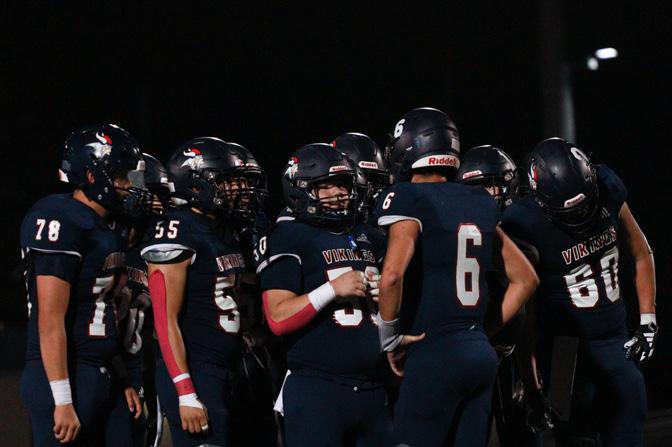




BY CHARLOTTE

As the rest of the class fnishes their projects, students around the classroom instinctively reach for their phones, creating a distraction for themselves and other students attempting to focus on the task at hand. Moments like this in the classroom have fueled debate around appropriate cell phone use in schools.
Currently, Lynbrook does not have a school-wide policy to mandate cell phone restrictions for all classes, but with the passage of the Phone-Free Schools Act by Gov. Gavin Newsom, this could change. The bill, signed into law on Sept. 23, 2024, requires schools to institute a policy limiting the use of cell phones throughout the school day by July 2026, bringing urgency to the conversation of how such a policy should be implemented. To best ft the academic environment at Lynbrook, the policy should balance restriction and fexibility, helping students improve their focus in the classroom while still providing access to cell phones when necessary for educational use.


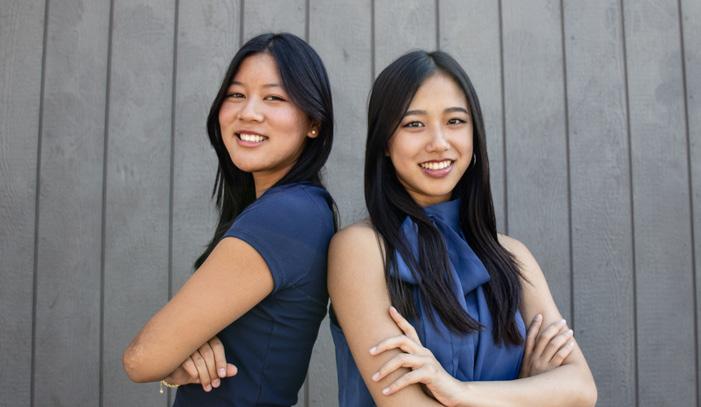
Salutations Vikings!
Welcome to the Epic’s frst issue of the 2024-25 school year! the Epic is Lynbrook’s award-winning student newspaper that seeks to cover stories that matter to our community. We are Alyssa and Ashley, your Editors-in-Chief. We would like to acknowledge our staff and adviser Mr. Miller, who all work tirelessly to write, design and edit our paper.
This year, we hope you join the Epic’s mission in sharing stories that matter to you. Submit any sub-200 word response to a piece from this issue and your sub500 word opinions on any issues relevant to our school, community, country and globe to us at enc.epic@gmail.com, both published on our paper and/or website. Flip through the pages and learn about ASB’s Legislative Council, delve into politics and wokeness, explore the work life of paraeducators, examine the partnership between San Jose and Cupertino and jump into the cricket team. We hope you enjoy Issue 1!
Happy reading, Ashley Huang & Alyssa Wang
Editors-In-Chief
BY ALEX COTTEREL

Engineering Club will host their third iteration of NorCal Hacks, their annual coding hackathon on Oct. 10-13. As in past years, the hackathon will take place virtually and is open to programmers of all skill levels. This year’s theme, the energy crisis, encompasses multiple tracks, including renewable energy and innovative energy technologies. After a series of workshops, attendees will develop a coding project tackling their track of choice. In past years, the hackathon has included collaborations with Machine Learning Club, Coding Art Club and Desmos-sponsored prizes.

On Oct. 10, the National Aeronautics and Space Administration is set to launch the Europa Clipper, a planetary probe headed toward Europa, one of Jupiter’s many moons. Europa has long been speculated to hold the potential to foster life. After $5 million and years of planning, the spacecraft will launch on a SpaceX rocket in Florida, before it fies past Mars and back by Earth, using the planets’ gravity to increase velocity in hopes to eventually reach Europa in 2030. Once there, the probe will make 49 close fy-bys to map the moon’s surface and investigate its ice shell.

In the Bay Area, homelessness has been a consistently discussed issue in recent years. Because of this, the City of San José hopes to redirect homeless individuals from public streets to city-sanctioned facilities by implementing a safe sleeping site. Current plans for the site include the establishment of about 100 tents with on-site security and a ban on drugs and weapons.
However, the proposition has faced a slew of backlash from local residents near the proposed site at 1157 E. Taylor St. who believe the site could compromise the safety of their community.

Claudia Sheinbaum took offce on Oct. 1 to become Mexico’s frst-ever female and Jewish president.
Sheibaum succeeds Andrés Manuel López Obrador who held offce for 6 years. A former mayor of the capital Mexico City, 62-year-old Sheinbaum has a background in engineering and leftist political movements. Sheinbaum won with a 60% lead of votes. Sheinbaum has made history, representing two groups never represented before in the highest levels of Mexican national government — 114 years after Mexico’s frst presidential election and 70 years after female Mexican citizens frst gained the right to vote.
BY YVONNE WU
This year, the ASB Legislative Council is working to create two new commissions centered around mental health and sustainability in an effort to organize new events and increase student resources in both areas.
Legislative Council representatives express the diverse voice of the student body as they vote on ASB budget distributions, new club and school events approvals.
“I joined Legislative Council because I wanted to help improve our school experience and be more involved,” junior and Legislative Council representative Angelina Zhou said.
Seniors and ASB co-vice presidents Kimaya Pantvaidya and Siddarth Gupta are the ASB leads driving efforts to create these new commissions. They have done so as a result of student feedback.
“At the frst meeting, we saw that all student representatives were taking initiative and pitching ideas freely,” Pantvaidya said. “We set up the framework for them initially and helped them organize and facilitate changes, but they are leading the discussions and planning the events.”
One major area of concern ASB heard echoing among the student population is the lack of accessibility to mental health support. As a result, they reached out to and worked closely with school therapist Jenna Starnes and FUHSD Social Emotional Learning lead Leila Lurie to form the Mental Health Commission. Mental health resources and facilities in other FUHSD schools like Monta Vista High School inspired the commission’s current plans. In order to fund largebudget projects, ASB leads have also been meeting with Principal Maria Jackson to discuss applying for grants.
“Right now, we are in the talks of creating a wellness base,” Gupta said. “Currently, we are the only school in the district that doesn’t have a physical space, like a wellness room, for students to gather in.”
Along with efforts toward the wellness center, the commission is working to set up an alumni panel by November.
“The main goal of this panel is to show students, especially underclassmen, that many stereotypes about having to be the best of the best at Lynbrook and getting good grades aren’t necessarily the key to success in high school,” Gupta said. “The panel will also allow students to explore post-high school options outside of attending a 4-year academic institution.”
While there are resources in place to support students in need, many are unaware of them or shy away from seeking external help. By creating initiatives to advocate for mental health care, Legislative Council can reduce stigma around the issue.

“I think a cultural shift is very important,” Starnes said. “We need to develop a school culture where it’s normal to take care of one’s mental and emotional health and where it is normal to utilize a wellness space.”

In tandem with the Mental Health Commission, the new Sustainability Commission will work closely with the FUHSD Climate Collective to coordinate school events promoting greener practices and sustainability. Senior and Climate Collective student board representative and president Arnav Singal has served as a liaison between the Climate Collective and Lynbrook to coordinate the commission’s creation.
“We want to do our part in educating everyone about sustainability and implement initiatives that reduce our carbon footprint,” Singal said. “It can’t be a responsibility we push to future generations.”
Most recently, the ASB leads, along with Singal and the Climate Collective team, have been working toward two main goals: setting up the new commission and a campus community garden for students. Although still in the early stages of development, the team also hopes to set up a system for Legislative Council Representatives to directly work with the administration to implement their own sustainability events and initiatives.
This year, the Legislative Council Sustainability Commission will also join the efforts of setting up the annual FUHSD Earth Day.
Compared to a previous ASB sustainability commission formed in November 2022, the new commission hopes to more heavily implement green practices while planning school events. Although initially formed to advise ASB on ways to stay more sustainable, the previous commission’s impact was limited by budget issues. However, the new commission, being made up of many non-ASB students, is more independent from ASB.
“The new sustainability commission gives ASB more purpose and will be able to hold it more accountable as opposed to previous efforts,” Singal said.
These combined efforts have been met with great applause from students, many of whom are hopeful to hear about the work the student teams and administration are putting into these areas.
I think the commissions are a great idea because many Lynbrook students struggle from the pressure of school work and college apps, so they push their mental health to the side. It would be nice for these initiatives to remind students to take care of not only themselves but the environment around them as well.


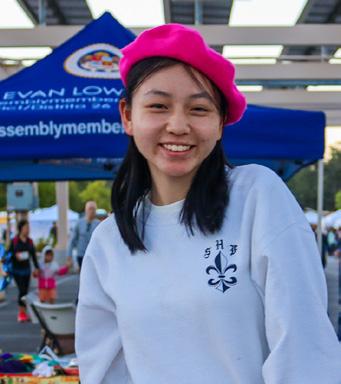

BY CLAIRE GUO
On Saturday, Sept. 14, French honor societies across FUHSD collaborated to host a booth at the Cupertino Night Market organized by the Cupertino Chamber of Commerce and De Anza College.
This is the frst year that a Lynbrook club took part in the market. Denise Schang, French teacher and Lynbrook French Honor Society co-adviser, was the frst person to fnd out about the event and share the possibility of a booth there with the FHS offcers. She believed that the night market was a valuable means of collaborating with other schools and sharing French culture with market attendees.
“It was a great opportunity,” Schang said. “Every school in FUHSD participated and students from across the district were able to share their passion. Supporting the students in sharing their interests in French with the community was our main objective.”


This collaboration was an effort sparked by Schang, Lynbrook FHS offcers and Elizabeth Louie, French teacher and Lynbrook French Honor Society co-adviser. Lynbrook FHS offcers frst reached out to the different French honor societies within the district. Each school added their own ideas for games and activities. Most of the planning was done asynchronously through Zoom during
the summer, but a week before the actual event, offcers met in person to create the trivia sheets, trifolds and posters.
“We hope that our booth allows the community to take an interest in French culture,” senior and Monta Vista FHS copresident Rowan Canogiu said. “We also want to promote our French classes and fundraise.”
At the booth, attendees tossed rings onto a miniature replica of the Eiffel Tower, tested their knowledge of French trivia, matched fags of French-speaking countries to their respective names and more. FHS volunteers handed out stickers and fyers for Petit Cours, an event where FHS members teach simple French classes to younger elementary students to spark their interests in pursuing French in the future.
“Our mission there was similar to our mission on campus: to promote our love for the French culture and language to the community, ” senior and Lynbrook FHS president Amine Ali Chaouche said. “We wanted to introduce people to some of the activities that we do at school like Mardi Gras and Petit Cours.”
Lasting well into the night, the market drew crowds with its lively and relaxed environment. It offered booths from other school clubs as well, such as Cupertino High School’s Japanese Honor Society. Food stalls sold a wide variety of dishes, from tanghulu to spicy chicken sandwiches, and small businesses sold jewelry and handmade crochet items. Additionally, cultural performances such as traditional Chinese opera singing were showcased on stage.
“I think it was really fun,” junior and night market attendee Amishi Arya said. “The FHS booth was really cute.”

Engineering Club Hackathon, Oct. 10-13
Engineering Club will be hosting its annual online hackathon, themed around the energy crisis. Attendees will participate in workshops and speaker events.
PSAT/NMSQT, Oct. 12
SAT, Oct. 14
On this day, the digital SAT exam for the district will be administered at testing sites in Homestead and Fremont High Schools.
Teacher Non-Duty Day, Oct. 14
“How to Talk to Your Teen About Current Events” Workshop, October 17
The free online workshop, hosted by the district in collaboration with YMCA Project Cornerstone, will guide parents through navigating conversations about sensitive news topics and current events with their teens.
Halloween, Oct. 31
View a decorated campus, dress up and participate in Halloween traditions! During lunch, teachers will open up their classrooms and allow students to collect candies.
BY MEADOW SHEN
Throughout the 2024-25 school year, FUHSD and Young Men’s Christian Association Project Cornerstone are jointly hosting free online workshops to help parents navigate their relationships with their teens. The workshops are geared toward helping parents and guardians express care for their kids in meaningful ways, navigate sensitive topics with their teens and improve family relationships. They cover a broad scope of topics ranging from managing anxiety to studying the adlescent brain.
For parents seeking assistance in fostering stronger relationships with their teens, these workshops are an accessible resource. As services such as counseling and therapy can be costly nowadays, these charge-free workshops have the potential to be especially impactful for families.
focused on the Developmental Relationship framework, which was developed in 2013 by Search Institute, an educational research organization. The framework includes fve key elements namely expressing care, challenging growth, providing support, sharing power and expanding possibilities.

bringing more relationship-building resources to families at Lynbrook. Her goal is to help parents learn how to foster stronger relationships with their teens.
“Project Cornerstone frmly believes in a partnership between students, teachers, parents and community members,” Headley said.
“One of the things that we do to help young people thrive is by educating their parents.”
This is an intriguing opportunity because Project Cornerstone is a proven, research-based program. It is promising to see the Project Cornerstone language and curriculum applied at a high school level.
Dr. Brittany Stevens School Psychologist
“ “
The frst workshop, “Creating Caring Relationships,” was held over Zoom on the evening of Sept. 26. The main focus of this workshop was helping parents improve their abilities in expressing care and support for their children, and learning how to connect and build trust in their relationships. In particular, the workshop
The structure of the workshops is centered around presentations led by Debbi Headley, Project Cornerstone school partnerships director, who covers the main topics in each session. During each workshop, parents are encouraged to ask questions or share their thoughts at any time during the presentation. Throughout the workshop, there are also refection activities to engage parents in the content.
According to Search Institute’s Developmental Relationships framework, relationships that beneft youth demonstrate these characteristics. A. Express care, B. Challenge growth, C. Provide support, D. Expand possibilities and E. Share power. Graphic illustration by Robert Yu.
Parent-teen relationships are a common concern for many families at Lynbrook. Stevens and school-based therapist Jenna Starnes work with Lynbrook students and parents who are concerned about their family relationships. They reveal that miscommunication and disputes over setting and respecting boundaries can be major culprits of confict.
“Parents may misunderstand their teens’ behavior or comments, just as teens may misinterpret the way that their parents are showing care,” Starnes said.
Realizing the importance of maintaining healthy parent-teen relationships, Headley and FUHSD therapist Leila Lurie organized these workshops in hopes of
A second workshop, “How to Talk to Your Teen About Current Events,” will be held over Zoom from 6:30-8pm on Oct. 17. The focus will be on helping parents navigate sensitive news topics and trauma with their teens.
In doing so, the objective is to protect students’ mental health, improve family relationships and help attendees be capable of recognizing legitimate news sources. Following this workshop, two more will be held in March 2025 that touch on the adolescent brain and managing anxiety, respectively.
Currently, FUHSD is working to improve its resources for members of its community who are struggling with their mental health, emotional wellbeing and family relationships. In the future, the district hopes to implement more accessible services and tools to make a difference.
“It is helpful for us to have conversations about the pressures that teens face along with their guardians’ hopes and dreams, and how we can build a bridge between the two,” Lurie said.
BY ALEX COTTEREL
In November, voters in parts of San Mateo and Santa Clara County will decide the outcome of a historic race for the 16th Congressional District in the House of Representatives, a district that encompasses parts of San Jose and Cupertino. The race sees former San José mayor Sam Liccardo and California Assemblymember Evan Low facing off for the frst District 16 seat to open in 32 years as they compete to replace retiring Democratic Rep. Anna Eshoo. The district’s jurisdiction includes many in the Lynbrook community.
“I think it’s important to be aware of all the levels of politics around you, especially local politics,” said junior and Politics Club president Chelsea Guo. “Since local politics are going to be the ones closest to you, they will defnitely affect you. So, it’s important to be involved or at least aware of the policies being passed on the local level because they targeted you directly.”
This race comes on the heels of Anna Eshoo’s retirement, who had made history as the frst Democrat and woman to represent District 16 in the House of Representatives. During her 32-year tenure, Eshoo earned acclaim from other high-profle Democrats such as House Democratic leader Hakeem Jeffries, who honored her achievements in a statement after the announcement.
“Traditionally, when we think of engineers, it is a male-associated stereotype,” government teacher Jeffrey Bale said. “So to have a politician like Anna Eshoo who
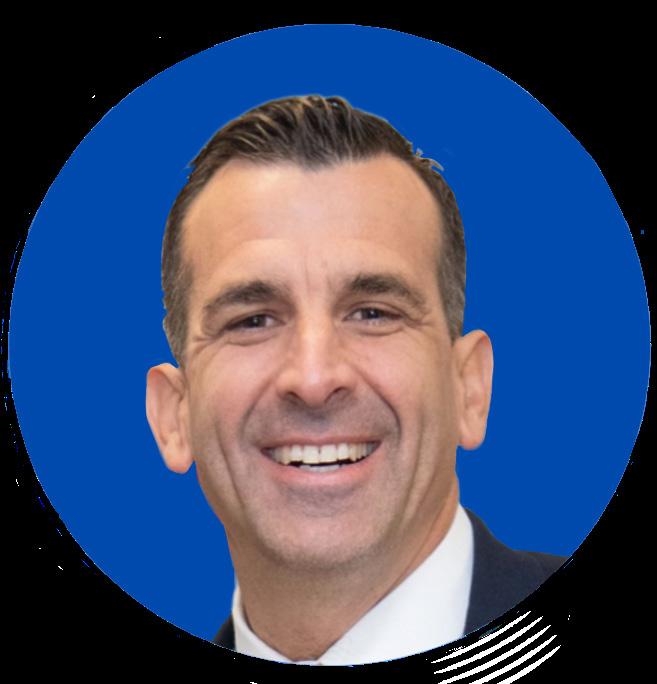
was very well-versed in technology, and who advanced that feld in Washington, was, I think, important. She was able to become a major player in pushing for Silicon Valley’s interests in the capital.”
The general election match-up came after a primary election dominated by Democratic candidates, with only two out of 11 candidates being Republican. Liccardo held a frm frst place, but the race for second place between Low and Santa Clara County Supervisor Joe Simitian was tense. In the weeks before the count fnished, the candidate that held the lead fuctuated, before the count ended stagnant, with both candidates receiving 30,249 votes.
The rare tie drew national attention and created the possibility of three candidates in the general election. A recount was requested by Dan Stegnik and Jonathan Padilla, who live in San Mateo County and Santa Clara County, respectively. The recount, which concluded on April 30 in Santa Clara County and March 5 in San Mateo County, unearthed several more votes for both candidates — Low ultimately received 12 more votes and Simitian received seven more, sending Low into the general election race against Liccardo.
The recount request faced pushback from those who questioned Padilla’s motives. Each day the recount occurred, Padilla was required to pay $12,000 a day in both counties to fund the recount. Padilla was Liccardo’s former campaign manager, prompting Max Zarzana, a prosecutor and Santa Clara County Government Attorneys Association president, to fle a complaint with the Federal Election Commission to hold Liccardo accountable for what Zarzana claims is evidence of a conspiracy. Through a post on X, Padilla says that he requested the recount to ensure that all legally cast ballots were acknowledged.
Prior to the recount’s completion, Low’s campaign issued a statement accusing Liccardo of being behind Padilla’s request, alleging that Liccardo tried to “subvert the will of the voters.” In a San José Inside editorial, Liccardo denied these claims, emphasizing the importance of recounts in close elections and the transparency of recount funding.
Both candidates have policies focusing on housing affordability, homelessness, cost of living, reproductive rights and environmental issues. As a House

representative, the elected candidate will have the power to push for Congress to address these issues in ways that will affect their district and pass initiatives that will support their constituents. Both candidates’ priorities include education. On Low’s website, he emphasizes his history of increasing funding for students in public schools as a State Assembly member and promises to do the same in Congress.
Liccardo’s website boasts the education initiatives he helped bring to fruition during his time as mayor of San José, and his plans detail goals of enhancing child tax credit, increasing teacher pay and boosting funding for children with special education and tutoring.
“Even though we know a Democrat is going to win, they need to win over Republicans and independents as well,” Bale said. “When it comes to consistency of character, it’s likely that more conservative individuals will vote for Liccardo. Evan Low, at this point, is going to be the underdog. The frst results show that Liccardo was able to capture much more of the vote, but it could go anywhere.”
As the election cycle approaches a conclusion in November, Low and Liccardo were set to face off in a debate moderated by NBC on Oct. 2 before Liccardo dropped out, citing voice loss from laryngitis.
BY ERIN FITZPATRICK
AB 3216, passed on Sept. 9, 2024, authorizes the governing body of a school district, charter school or county offce to limit or prohibit the use of smartphones while students are in school or under the direct supervision of a school employee. Schools must create and institute rules restricting the use of cell phones by July 1, 2026. This bill builds upon AB 272, which was passed in 2019 and gave school districts authority to regulate cell phone use in the classroom, but did not require them to do so. The bill text cites growing evidence that unchecked use of smartphones in schools lowers student performance, promotes cyberbullying and increases both depression and anxiety. AB 3216 is classifed as a state-mandated local program, which requires local offcials to carry out or expand on what the bill entails.
“I think it would be in the best interest of everyone involved,” physics teacher David Taylor said.
“Even if we ban the phones, we’re becoming so reliant on other devices that kids might use those instead.”
SB 1047, passed on Sept. 30, 2022, focuses primarily on expanding childcare and learning programs in California. Under SB 1047, families who rely on state-funded childcare will no longer have to consistently reapply yearly for assistance.
This bill also prioritizes those in need, like lowincome families or homeless people. Additionally, it stresses the importance of education for young children and expands on access to early learning programs for children in kindergarten. According to the bill, ensuring that children get early learning care — especially those who are marginalized and excluded from the opportunity — can reduce the impact of systematic racism and poverty.
“Early childhood education is critical in our children’s development, which is why I am grateful that Gov. Newsom has signed SB 1047 to expand the enrollment of childcare programs throughout the state,” Senator Monique Limon said in an interview with Early Edge California. “SB 1047 will help provide California children with more
AB 2429, passed on June 13, 2024, will require school districts to continue education about the danger and harm that fentanyl can cause. It specifes that any high school district or charter school that offers a health course for graduation must include informative lessons on the impacts of fentanyl. This bill includes Lynbrook, starting in the 2024-25 school year. These presentations will include, but are not limited to, the differences between various opioids, drug lacing and overdose risks and prevention.
According to the San José Mercury News, one in fve overdose-related deaths in adolescents are linked to fentanyl. This bill was created in response to the overwhelming infux of opioidrelated deaths nationwide and will take effect in the 2026-27 school year.
them up for a successful


problems, the more we can make informed decisions,” sophomore Jayce Tseng said. “Drug usage should not be a subject schools avoid because it’s dangerous or bad; students should be exposed to the topic to gain a better understanding.”


Story continued from front page.
Some school districts have already taken the initiative to regulate phone use, such as the Los Angeles Unifed School District, the largest nationwide district to ban cell phones. In FUHSD, specifcally at Lynbrook, teachers are free to choose and enforce their boundaries regarding phone use in their classrooms.
Since this bill is fairly new, Lynbrook does not yet have a set plan for how it is going to be implemented. According to Principal Maria Jackson, the district will eventually establish a policy framework for all of its schools. Until then, teachers and staff should encourage students to pay attention in class and to only use electronic devices responsibly and when needed.
“This act would be great because most teachers dislike being the bad guy,” physics teacher David Taylor said. “A blanket rule would make it much easier since the phone is a huge distraction for students.”
For many, cell phones permeate their lives: from storing important contacts to housing their favorite games. With so much available at students’ fngertips, it is challenging to stop technology overuse. According to a 2023 study by the Pew Research Center, around 72% of high school teachers view cell phones as the main distractor in the classroom. By keeping cell phones out of students’ reach during instruction, teachers can more effciently maintain a focused learning environment in which their students can thrive while implementing technology to further their education.
“In the past, students used to love watching movies in class,” language arts teacher Connie Willson said. “Now, some of them struggle to pay attention

to a movie because it’s a long, sustained period of time. Also, just being able to focus on tasks is a struggle.”
Some of the main distractions that students struggle with are Instagram and Brawl Stars, an online multiplayer game. The addictive nature of both apps makes it easy for students to lose focus during a lecture or slack off during class, which creates a poor learning environment.
classmates with different schedules may become tricky with a lack of phones.
“Cell phones have become so ingrained in our way of life that there might be a lot of backlash about having no cell phones at all from both students and parents,” Taylor said. “Best case is students can keep them in their backpacks during the day and then take them out at the end of the school day.”
in the phone holder at the front of the class,” Willson said. “I take attendance based on whose cell phone is there.”
Willson’s policy, which she has enforced for around fve years, is benefcial because it keeps phones out of students’ reach while making them easily accessible in an emergency. While some students could lie about not having a phone, a district-wide policy should create consequences if students are caught with their phones.
I have students put their cell phones in the phone holder at the front of the class. I take attendance based on whose cell phone is there.
Connie Willson English teacher
“ “
Although the bill does not solve the problem of phone addiction in general, it helps by slowly breaking the habit of reaching for a phone as soon as boredom hits. Overuse of a device causes psychological reliance, according to Butler Hospital. Phones are a source of endless dopamine, and while they can be a relaxing way to wind down at the end of the day, constant reward-seeking prompted by the excess of dopamine is a slippery slope that can quickly lead to addictive behaviors. With a clear policy in place, school districts can become more effective places of learning, teaching students the importance of balance and control when it comes to phone use.
However, one potential drawback of a complete ban in schools is the cutoff of communication. From emergencies to daily pick-ups and drop-offs, clear communication between students and parents is essential for many families. Along with family contact,
editors-in-chief — ashley huang, alyssa wang
managing editor
— lilly wu
copy editors — qianzi loo, emily pedroza
design editors
— vidushi upadhyay, eileen zhu
news editor — olivia yuan
When forming Lynbrook’s cell phone policy, it is vital to consider all these factors while also realizing that phones can sometimes be a healthy addition to the classroom if monitored and used responsibly. For example, art students may need a device to reference photos conveniently or keep progress of their work over the school year.
“I think that phones can be used educationally,” junior Zenita Yang said. “When I use my phone in class, I’m usually just searching for information I need for classwork or homework.”
Conversely, most classes are taught with minimal phone use. If a teacher chooses to implement tools such as Quizlet Lives and Kahoots, integrating cell phones into the classroom can happen responsibly and in a way that enriches learning rather than distracts students.
“I do think that a lot of times people don’t use their phones for educational purposes,” Yang said. “I think they should be put away when they become a distraction, but it just depends on the class.”
“With my policy, students are more on task,” Willson said. “They interact with each other more and they don’t pick up their phone every time they hear the buzz of a notifcation.”
In the end, students must take it upon themselves to ensure they are using their phones responsibly, whether by using them to enhance their learning experience or by storing them in their backpacks during class time.
72% of high school teachers view cell phones as the main distractor in the classroom
According to the Pew Research Center
Otherwise, keeping them out of students’ reach is the best way to ensure they receive quality education.
“I have students put their cell phones
stafers
akash anand
opinion editors — crystal zhu, david zhu
in-depth editor
sports editor
web editors
charlotte bolay
anushka deshmukh
angelina feng
Additionally, FUHSD could take the initiative to not only limit phones, but also educate students through lessons on cell phone addiction and how to stay focused in class. Phones in students’ hands should serve a greater purpose than a means of procrastination and distraction during classes. To achieve this, FUHSD could implement an effective policy for the entire district restricting students’ access to their phones during class time, ensuring students stay on task and are able to prioritize learning.
the Epic staff voted 28-2 in favor of this stance with 10 abstaining.
rohan kakhindiki
brian lee
olivia tu
ethan wong
adviser
— josh miller
business/pr manager features editor — claire guo
— alex cotterel
— amanda jin
— meadow shen, yvonne wu
— taek kim
social media manager — inaaya yousuf
rebecca cai
anna cen
maddy chang
isabella chiu
erin fitzpatrick
kieran hau
irene hwang stuti jain
valued contributors: Guojing Liu
gary pan
saavan saraf
carrie song jenny suh
alexandra wu
cecilia wu
robert yu
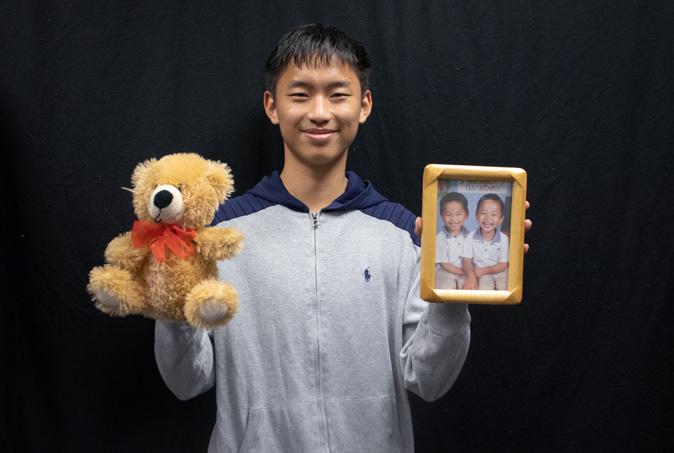
Photo by Gary Pan.
BY DAVID ZHU // IN MY OPINION
On lazy Saturdays in ffth grade, I spent entire afternoons outside exploring the neighborhood and digging around my garden. At that age, freedom from responsibility meant that I had a seemingly infnite amount of time on my hands. The neighborhood was my endless playground. Hours upon hours were spent playing hide and seek and
lifting stones to see what was underneath. Yet, as vividly as these memories once flled my mind, I fnd them fading away as I enter my junior year of high school. Juggling an ever-increasing amount of work meant that I could no longer live life with the carefree nature of my childhood.
I remember the simplicity when my family lived in a quiet Sunnyvale neighborhood. In the evenings, my brother and I would bike through the neighborhood for hours. On some days, my mom would take us on a long walk to Las Palmas Park where we zoomed down the playground slides and dug in the sand pits. I was an adventurer of an unexplored frontier as I scaled the playground’s boulders. Every trip to the park was a new quest, every bike ride an expedition.
My bubble burst when my family moved to San José in the summer before sixth grade. I was thrust into a completely new environment with unfamiliar faces. When my brother and I started attending Miller Middle School, I focused on ftting in while being introduced to teachers who
assigned copious amounts of homework and students who were laser-focused on their academics. As the school year progressed, memories from my life in Sunnyvale seemed to grow distant. Walking home from Miller one day, I noticed how quiet the neighborhood was, void of any sounds of laughter or chatter. I was hit with the realization that I had not heard the sounds of children playing in a long time. I thought back to those untroubled moments in elementary school when I chased my brother through the park. But now, I could hardly recall the last time I played a game of tag or spent hours outside.
As I journeyed through middle school and soon entered high school, I continued to grapple with leaving my childhood hobbies. Frustration arose out of not fnding the same joy in stepping foot outside and exploring like I once did. However, high school introduced me to a plethora of opportunities, and I developed new interests. Curiosity toward having meaningful discussions about the world
led me to join debate. The appeal of exploring a new culture led me to join Spanish Club. My interest in learning more about political issues that affect my life led me to join Politics Club. Even though I was no longer exploring playgrounds, my love for adventure manifested in my desire to explore the world around me.
Sometimes, I wonder what my life would be like if I were still living in that quiet Sunnyvale neighborhood. Sometimes, I wish I could go back to those simpler days. However, as I’ve spent more time exploring new interests, I’ve come to recognize the importance of change. In these past few years, change has distanced me from my childhood, but at the same time it has transformed me to the self I’m proud of today. Change is something I can’t escape, but it is something I’ve learned to embrace. Although I may no longer fnd myself on long neighborhood expeditions, I will always look forward to what’s ahead of me, ready for my next adventure.
BY TAEK KIM AND SAAVAN SARAF

In classroom discussions, debates and across social media, the term “woke” has become a lightning rod for criticism. What began as a call to social justice has been weaponized by conservative politicians as an insult for liberals, fueling the fre of political polarization and stifing pertinent discussions. Hostility toward wokeness is the foundation for many right-wing political infuencers, who eagerly divide Generation Z with their fery rhetoric on social media.
In September 2024, conservative commentator Charlie Kirk visited Pennsylvania State University, where he bashed a “woke” student for being radical and overly-sensitive in a question and answer session. A video of the altercation posted to Kirk’s YouTube channel has over fve million views.
To Kirk and others like him, “woke” describes someone who has extreme left-wing views on race, gender and sexuality. This is the basis for the way they want to portray all liberals: forcing queerness on kids, being anti-family and hating white and cisgender people. It’s an image that’s easy to spread, and more importantly, easy to make fun of.
“Wokeness has been appropriated by the political right as a disparaging term for those part of progressive movements or people whose opinions counter traditional ideological beliefs,” social studies teacher Mike Williams said. “The other side of wokeness means to be aware of things that you weren’t aware of before, possibly leading to empathy for these progressive issues.”
The term “woke” originates from Black vernacular slang. “Stay woke” was a popular phrase calling on Black Americans to be aware of the dangers of racism in the 1930s. In the 2010s, it broadened to describe a new social justice movement: one that focused heavily on diversity, equity and inclusion — often, some believed, to the point of policing the speech and actions of others.
Students and professors alike have raised concerns about liberals who identify with wokeness and their effect on free expression on college campuses. In a 2023 op-ed in “The Boston Globe,” Harvard University Professor Steven Pinker argued that woke ideology suppressed meaningful political discussion at

Harvard. Conservative students and professors censored themselves to avoid backlash from the school’s leftleanings. According to the Foundation for Individual Rights and Expression, there were 877 attempts to punish professors for speech protected under the First Amendment between 2014 and 2022.
Valid concerns about extreme wokeness were cut short by a right-wing crusade. Politicians use an “us versus them” mentality to isolate those considered woke for not having “normal” political beliefs. Wokeness quickly went from something liberals were proud of to a taboo slur.
“

people believe these pronouns have no basis in reality.”
Ben Shapiro, colleague of Kirk and host of “The Daily Wire,” a conservative YouTube talk show, visits universities, painting himself as a martyr for free speech in the face of woke wrath. The frebrand commentator shoots down “woke” students with insults and quips. People who challenge him are often cut short by a mute button or shouted down by a crowd. Each conversation ends the same way — Shapiro triumphing over wokeness through a selection of token one-liners, with nothing gained on either side.
If we’re able to get folks to sit together and have conversations, we would quickly realize that there are more similarities than differences.
Alice Siu Stanford Deliberative Democracy Lab Director
“The entire effect is to try to generate outrage among their audience, which Shapiro and Kirk do,” San José State University political scientist James Brent said. “We’ve seen Donald Trump talk about eating dogs and cats — that came from a right-wing ecosystem which Ben Shapiro is a part of.”
The anti-woke sentiment has bled into younger generations. Shapiro alone boasts over 13.9 million followers across YouTube, Instagram and TikTok, many of them a part of Generation Z. He markets a stoic, unemotional persona to his viewers. His catchphrase, “facts don’t care about your feelings,” stigmatizes personal experiences and rejects the fact that emotions are irrevocably tied to politics. He spreads misinformation, like arguing that transgenderism and homosexuality are mental illnesses, and encourages young people to dismiss them as woke.
In high schools, this attitude can create a hostile environment for students. Homophobic hate crimes and bullying have quadrupled in states with laws targeting LGBTQ rights since 2023. In most high schools, the occasional bout of transphobia is inevitable.
“You will hear a lot of jokes about zey/zem pronouns,” sophomore Raghav Shrivastava said. “Some
People tend to block out ideas they’re not familiar with. A lack of exposure to others’ experiences may be the reason for students’ behavior. “Our campus, in particular, does not accurately resemble the real world, as we are a 90% Asian population and live in a bubble of privilege compared to other environments,” senior and copresident of Lynbrook Model United Nations Elizabeth Jiang said. “In some ways, the lack of perspective doesn’t drive critical thinking. There’s not much motivation to be empathetic if you feel you’re above everyone else.”
“The term “woke,” like many other labels, reduces complex social issues to a simple distortion, shutting down meaningful discourse. It dismisses the substance of an opponent’s idea by placing it under the umbrella of a single word.
“The Daily Wire” has dedicated its entire platform to the cause. While the company still covers national politics, several sister channels of the show, including “Michael Knowles,” “The Comments Section With Brett Cooper” and Shapiro’s own personal segment, are fxated on scouring the internet for the most extreme views on identity politics and passionately striking them down as woke liberal ideas.
“Labeling has always been a part of American politics,” Brent said. “The things you do are labeled as great, while what the other side does is undermining American democracy.”


Scan for the full story.
BY OLIVIA TU
As the week fuctuates through chilly winds to scalding sun rays, one student remarks that the “weather is so bipolar.” Relaxing in a room devoid of trash, sheets freshly folded, another student claims they have “OCD” because they prefer to be organized. This casual use of mental health terms has grown increasingly prevalent. Although this misuse may seem trivial, using casual language regarding mental health can have harmful consequences and serve as a greater refection of society’s prejudice toward those who struggle with various conditions.
In recent decades, mental health concepts have undergone a linguistic phenomenon known as “concept creep” where ideas are experiencing semantic infation as terms expand from their scientifc meanings to ones that include vaguely-related situations. Mental health terms such as “anxiety” and “depression” have been broadened to include less severe feelings of sadness or worry. Although concept creep acknowledges the suffering that mental health conditions infict, it trivializes those illnesses and pathologizes regular emotions. According to a study from the National Library of Medicine on semantic change, this may lead to more dramatic responses to milder experiences.
potency and get defned in other ways,” school psychologist Brittany Stevens said. “One of the issues with using offcial labels casually is when they start to lose their actual meaning, different to how they’re used in a clinical setting.”
According to the World Health Organization, around 13% of 10- to 19-year-olds have experienced a mental health disorder. In addition, both depression and anxiety diagnoses in adolescents have increased over time from 5.4% in 2003 to 8.4% in 2012, as stated by the Children’s Health Center. Given the considerable number of teens who have been burdened by mental health issues, it’s crucial to be mindful in approaching and discussing these issues. To start, we should refrain from using mental health terms in a negative or joking manner.
13%
“Among teens, there’s still this belief that there’s something wrong with you if you’re having issues with your mental health, which is strange because we’re more than just our bodies,” school therapist Jenna Starnes said. “We still have a lot of progress to make in terms of destigmatizing mental health and encouraging more teens to speak up about their struggles.”
of 10-19-year olds have experienced a mental health disorder
According to World Health Organization.
“It’s very common for people to say that they’re bipolar or depressed when they don’t have the diagnosis,” said junior and vice president of the Psychology and Sociology Club Tanishi Bhushan. “It can be diffcult to articulate their feelings.”
Mental health language is also associated with the phenomenon of semantic satiation, which occurs when repeated use causes a word or phrase to lose its meaning. This phenomenon erodes the seriousness of mental health conditions, downplaying the illness and diminishing debilitating conditions to everyday, simpler experiences.
“Words change over time — they lose
There are a multitude of words used today that are derived from obsolete medical terms and are considered ableist or insulting due to their previous connection with mental health conditions. For instance, the word “lunatic” referred to mentally ill people in the “lunatic asylum.” It was later replaced by “insane” because people with mental health conditions were perceived as lacking reason. Once these psychiatric vocabularies were reformed, they shed their medical meanings to be used in colloquial settings while retaining some of their offensive connotation. These diagnoses still carry bias today; terms such as “loony” or “manic” are often used to label something as irrational or senseless, surrounding them with a deprecatory meaning.
Both negative stigmas and trivialization of mental disorders can decrease the likelihood of adolescents speaking up. Teens may feel as if they’re

MEach book on my bookshelf is a piece of art that I can
out and appreciate. Be it
the deckled edges, reading old annotations or touching the texture
overreacting, and describing their illness to others turns strenuous since they are unable to differentiate their complex condition from stereotypes perpetrated by everyday slang. Discouraged from seeking help, they may suppress their struggles, leading to serious health problems later in life.
“Slang terms that are too lighthearted or funny can make people less likely to seek help because they feel like they’re making fun of themselves,” Starnes said. Conversely, normalizing the correct use of mental health terms can enable teens to get the support they need and feel validated. Since these clinical labels, or mental health terms, possess a shared understanding, teens may use clinical labels as a way for others to understand their struggles, enabling them to communicate about their problems healthily and without fear of being misunderstood. Although it allows others to recognize their feelings, it masks people’s underlying problems because their true feelings are not expressed.
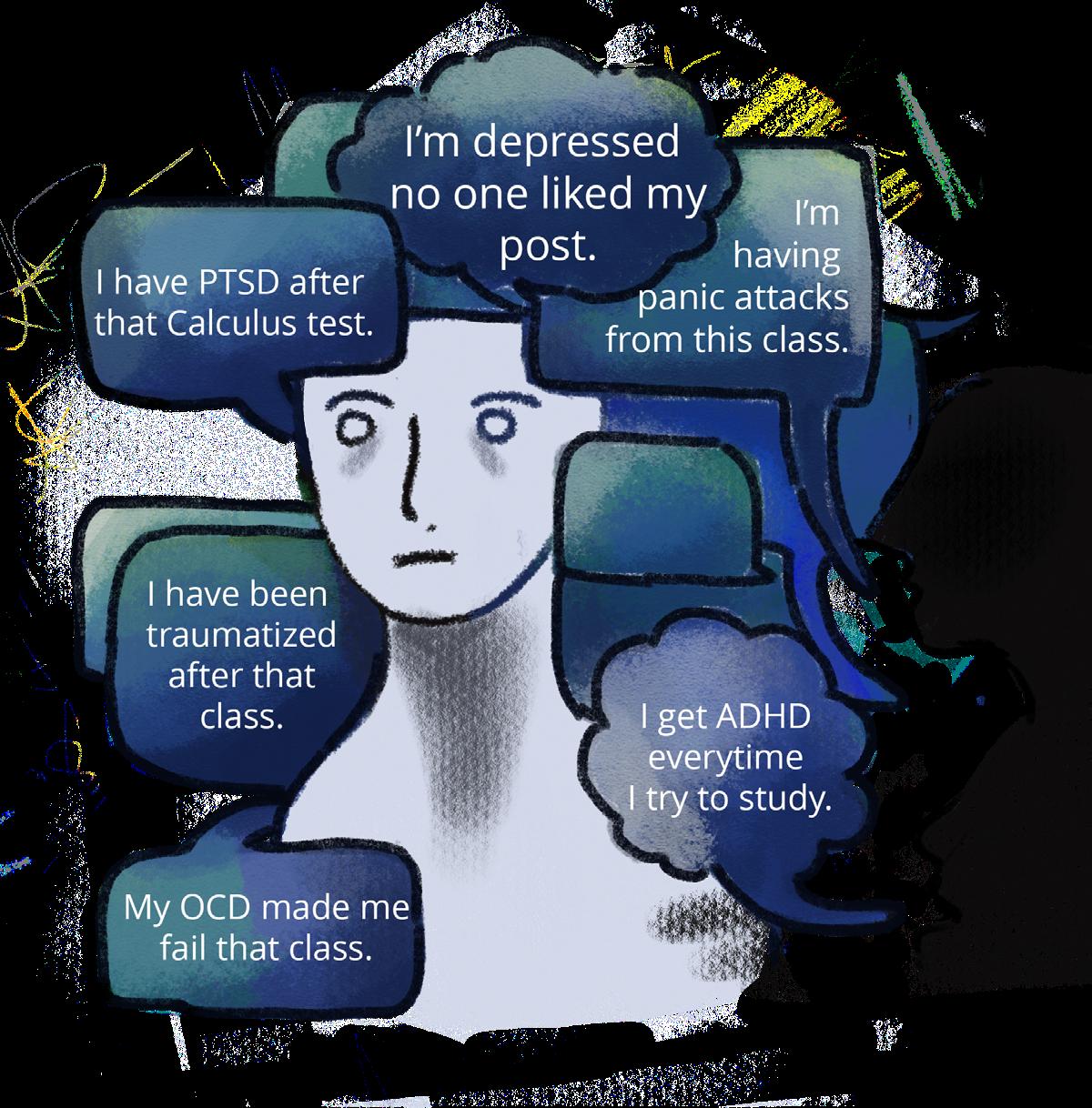
humor through slang can be a coping mechanism for those struggling, allowing them to distance themselves from their problems and let others know that they are not alone.
“A lot of people in the media joke about mental health, and it’s kind of like putting on a mask,” senior and Activities Director of Psychology Club Dorothy Ko said. “However, since this slang is being used so much, viewers can see that other people are going through it too, making them think it’s okay to ask for help.”
“The tendency to label is rooted in wanting your feelings to be validated, but your feelings are real whether or not there’s a label,” Stevens said. “It’s important to talk about your true symptoms and feelings.”
Social media plays a pivotal role in the normalization of mental health terms. As seen through a multitude of platforms, mental health slang surfaces in content trying to appear relatable through humor. Although a humorous approach can make conditions seem less intimidating, it oversimplifes mental health conditions because terms such as “hyperfxating” and “trauma” have become hyperboles. It can blur the lines between a joke and a serious call for help. On the other hand, using
of the book cover, every single copy has distinctive details that communicate its past. Every book I’ve read was an adventure, and every book not read yet will be a future adventure. Each book’s spine, whether cracked or pristine; each annotation, whether by me or a past owner and each hardback, whether missing its dust jacket or not, all represent a unique history to me that I would be unable to appreciate to the fullest degree if they were a digital library. It’s like looking at Van Gogh’s “The Starry Night” through a screen, unable to appreciate the layers of paint and effort within the work.
Growing up in a digital world, some of my earliest memories involve a screen. Games like Angry Birds and Cut the Rope were mainstays of my childhood experience. As I got older, everything in my life seemed to become digital. I traded DVDs for streaming, the Garfeld comic books for YouTube, the physical notebooks I had for the Apple Notes app and the playdates of my childhood for texting.
The digitalization of my entire life reached a climax in my sophomore year when I picked up reading again. At frst, I read only PDFs, fnding the ease of access to eBooks, but I found annotations and marginalia an impossible task to do without a physical book. Following this revelation I’ve begun to turn my back on the rapid digitalization of my life in favor of the physical. In an age of mass media, I’ve sought the refuge of the wornout pages of a second-hand book. A beat-up Penguin
Although the casual use of mental health terms offers a lighthearted approach to diffcult experiences, it’s important to be empathetic toward those who suffer from mental health conditions by talking with sensitivity and choosing accurate words to describe genuine feelings. Students should educate themselves on the severity and details of the conditions, as well as spread awareness and encourage discussion around them.
“Many people use labels for their feelings to be legitimized, since there’s a real meaning in having an actual diagnosis,” Stevens said. “However, people should say things that more accurately capture what they’re experiencing.”
Classics of “Moby-Dick”, with the edges falling apart; faded highlights blending in with the sallow page and an old boarding pass to Cincinnati in place of a bookmark. These all serve to improve the book’s appeal. Its past ownership isn’t a defect, but a feature. The tangible is something real, something I can hold on to, something I can look back on and reminisce upon, some memory that can be triggered with a simple stimulation of the fve senses: touch, taste, feel, sight and smell.
Most of all, the analogs are objects I can feel. Just like feeling the crumbling pages of my second-hand copy of Moby-Dick, I fnd a warm embrace from a friend comforting. After all, can love exist without physical experiences? Experiences as fundamental to my life as hugs, taking walks at dawn and basking in the smell of the morning dew. Handwriting birthday cards or delivering out small gifts can’t happen in a digital world. Most of my senses — crucial to daily life — are ignored in a digital setting. Physical objects enrich my personal life, and bestow meaning and love in the small things, making the insignifcant truly special.
Digital experiences will never be as powerful as physical experiences. In a digital world full of growing polarization and decreasing attention span, I have found meaning in experiences found only in the physical: slowing down to appreciate the mundane.
BY JENNY SUH
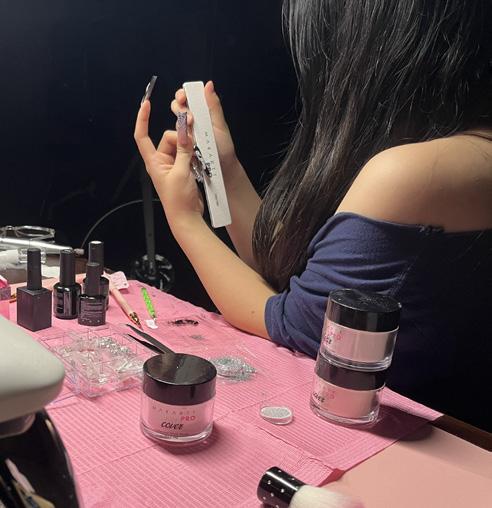


As the potent smell of nail polish and dust from her electric drill flls her garage, junior Alison Lin sits with a client, carefully shaping each
sculpts the 3D gel and lifts the wax business, Acrylicz by A, Lin
acrylic nails for her clients who
Lin’s passion and curiosity for

would often wear on vacation and at school dances. After experimenting with
a variety of different sets, she dove into acrylic nails, something she could have more creative freedom with. Through YouTube tutorials, she taught herself the key aspects of nail care, shape and design. Lin purchased a beginner’s acrylic kit in early July that provided her with all the basic tools of acrylic powders and brushes. This set was a stepping stone for her to gain hands-on experience with proper tools instead of simply observing others through a screen. While acrylics were completely different from press-ons, Lin could focus more on precision and each detailed element.
“Getting into nails wasn’t an easy process for me since no one I knew had experience creating them,” Lin said. “I had to rely a lot on online resources and the tips of other nail technicians and continuously practice on myself with a pop offset.”
While Lin had always enjoyed doing her nails, her inspiration to transform a hobby into a business sparked after getting her nails done for her 16th birthday by a nail technician who was around the same age as her. With the help of her mom, Lin purchased more professional tools including a dust collector, cuticle pusher and electric nail drill. In her spare time, she explored different square, almond and lipstick-shaped nails, growing her technical skills. As she expanded her workspace and collection of tools, she outgrew her room and soon moved to the garage, where she would spend most of her time perfecting her craft.
“The nail tech that I went to was already running her own business after only starting nails one year ago,” Lin said. “This inspired me to start my own business after thinking about how hard she must have worked and the effort she put in to become successful.”
This summer, Lin jumpstarted Acrylicz by A, a nail business that brings her client’s creative nail designs to life while combining her own fair. She began by only offering her services to a smaller client list, mostly
consisting of her close friends. Her frst client and closest friend, junior Chloe Chung, would often lend Lin her hands, allowing Lin to practice nail shaping, application and design. Lin was able to further hone her skills with Chung’s consistent support and feedback. She was also the frst person to suggest the use of social media like Instagram and TikTok to enhance brand awareness, something Lin had never thought of approaching.
“It was a very trust-the-process situation,” Chung said. “It was mind-blowing to me how something so simple like nails can develop into something really complex.”
Through short-form videos and images on social media, Lin was able to create content and market her work to showcase her different nails and techniques. Amassing over 200,000 views, 40,000 likes and 300 followers across all her platforms, her online presence has grown quickly and has attracted a larger audience interested in her services.
“My social media platform allows me to spread my work online and reaches more people compared to in person,” Lin said.
Looking ahead, Lin hopes to expand her clientele and increase her visibility on social media to eventually move her business online while continuously working in person. She also aims to offer a wider variety of services, including custom press-on nails and gel nails. Through a higher online presence, Lin plans to target clients who don’t have long hours to commit to getting their nails done or clients who live further away.
“Even though starting this business has had its challenges, watching it grow has been extremely rewarding,” Lin said. “While it originally started as something I do in my free time, it has now blossomed into a small business where I have grown a lot as a nail technician.”
BY AMANDA JIN
As seniors Felicia Huang and Seth Leung open up the oven, the warm and sweet, browniescented air flls the kitchen, ready to be packaged for this month’s customers. Cutting through the chocolate pastry and placing them into custom packaging, the duo prepare the brownies to be picked up by students. Through their variety of affordable dessert options, Big Buns Bakery brings convenient sweet treats to Lynbrook’s campus.
Originally, they had developed their interest in baking independently. Huang gave sweet treats to her volleyball teammates, classmates, friends and even teachers, delighted to see others enjoy the sweets she made.
Leung found his passion for baking through a different path, developing his interest because of his mother.
“My mother’s a baker and her dream is to open a bakery one day,” Leung said. “I grew up learning a lot from her. Many of my recipes are modifed versions of her recipes.”
Being in the same history class in junior year, they noticed that they both often brought baked goods to share and decided to collaborate, merging their passions for baking. Eventually, Huang and Leung decided to turn this activity into a business, so they could earn enough to cover the expenses of ingredients. One of their main goals was to sell items at low prices, especially since most commercially sold pastries are quite expensive.
“We wanted to make our products cheap and affordable without losing money,” Huang said.
Every month, Big Buns Bakery releases a new menu for customers to
order from. The menu contains a standard cookie option, which changes favor according to the month. In August and September, the featured favors were matcha and S’mores, respectively. In addition to these products, Big Buns Bakery also has exclusive monthly pastries.
“We try to have two to three unique menu items every month,” Leung said. “We take recommendations for items from our friends and customers. We also include things that we personally like.”
In the frst month of being in business, the bakery saw great success in sales, with over 40 sales. Many of the students who ordered greatly enjoyed the pastries.
“I had ordered the pineapple bun, which was very delicious,” freshman Richard Yu said. “The texture was nice; it was soft on the inside and crunchy on the outside. The packaging even had cute stickers.”
However, the bakery ran into a couple unexpected issues along the way. On their Instagram page, @bigbuns._ bakery, a Google form is linked where customers can input their orders for the month. Since the form was available to students throughout the whole month, Huang and Leung were met

with a lot of confusion.
“We just had our frst month, which was all over the place,” Leung said. “Since orders were constantly coming in, we had to bake in multiple sessions.”
In order to combat these issues, they planned on only releasing the order form at the beginning of the month for a few days to minimize the amount of sessions needed to bake. They also plan on deciding on a single pickup location and time for customers.


Huang and Leung aim to beneft the student body not only with the sweets but also through the profts generated from sales by donating to clubs. The duo have also decided to donate to a local nonproft, Jumpstart Sports Foundation, which provides sports equipment to marginalized communities.
“Jumpstart Sports Foundation is an organization run by students at our school,” Huang said. “They donate sports equipment and other resources to marginalized communities. It’s meaningful because I do sports, and I hope others get the same opportunity as well.”
With the newfound success of their business, Huang and Leung hope to reach a greater audience, allowing more people to enjoy their lowcost sweets. As sales increase,
they also hope to donate and support more students as they continue to pursue their passion in baking.

• 1 cup all-purpose four
• ½ teaspoon baking soda
• ¼ teaspoon salt
• 6 tablespoons unsalted butter
• ½ cup granulated sugar
• 3 tablespoons brown sugar
• 1 large egg
• 1 teaspoon vanilla extract
• ¾ cup chocolate chips
• Mini marshmallows
• Graham crackers
• Secret ingredient
BY BRIAN LEE AND EMILY PEDROZA
From accompanying students on offcampus trips to attentively taking and uploading individualized notes to Schoology, Lynbrook paraeducators play a key role in the success of the special education department, helping make Lynbrook a more vibrant campus.
The resource department helps all students on an individualized education plan, which provides a roadmap for students with disabilities across functioning spectrums and ensures their overall success. Paraeducators can often be seen taking notes in the back of classrooms, mastering a wide range of classes and subjects and adapting to different teachers’ lesson structures. They later reteach and relay this knowledge to their students.
A. Group photo of resource paraeducators: from left to right Narasimham, Balasubramanian and Saxena.
B. Lalitha Balasubramanian
C. Ranjani Narasimham
D. Om Khandekar, paraeducator working under SOAR
Photos by Brian Lee.
Lalitha Balasubramanian
Balasubramanian, now in her 17th year of teaching, began her career as an accountant in India, but after immigrating to the United States and volunteering in her children’s classes, she felt her interest in teaching grow.
Since then, she has worked in elementary, middle and now high schools across the Cupertino Union School District and FUHSD.
“Although I have worked with students from kindergarten to 12th grade, I was so surprised how disciplined and wellbehaved Lynbrook students were,”
Balasubramanian said.
On top of her role as a paraeducator, Balasubramanian also serves as one of Lynbrook’s transition specialists who support special education students in establishing clear paths after high school, whether that involves applying for colleges or jobs related to their interests.
“We can actually, over the span of four years, see the result of helping our students — it gives us happiness,” Balasubramanian said. “Seeing the students’ success is everything for us.”
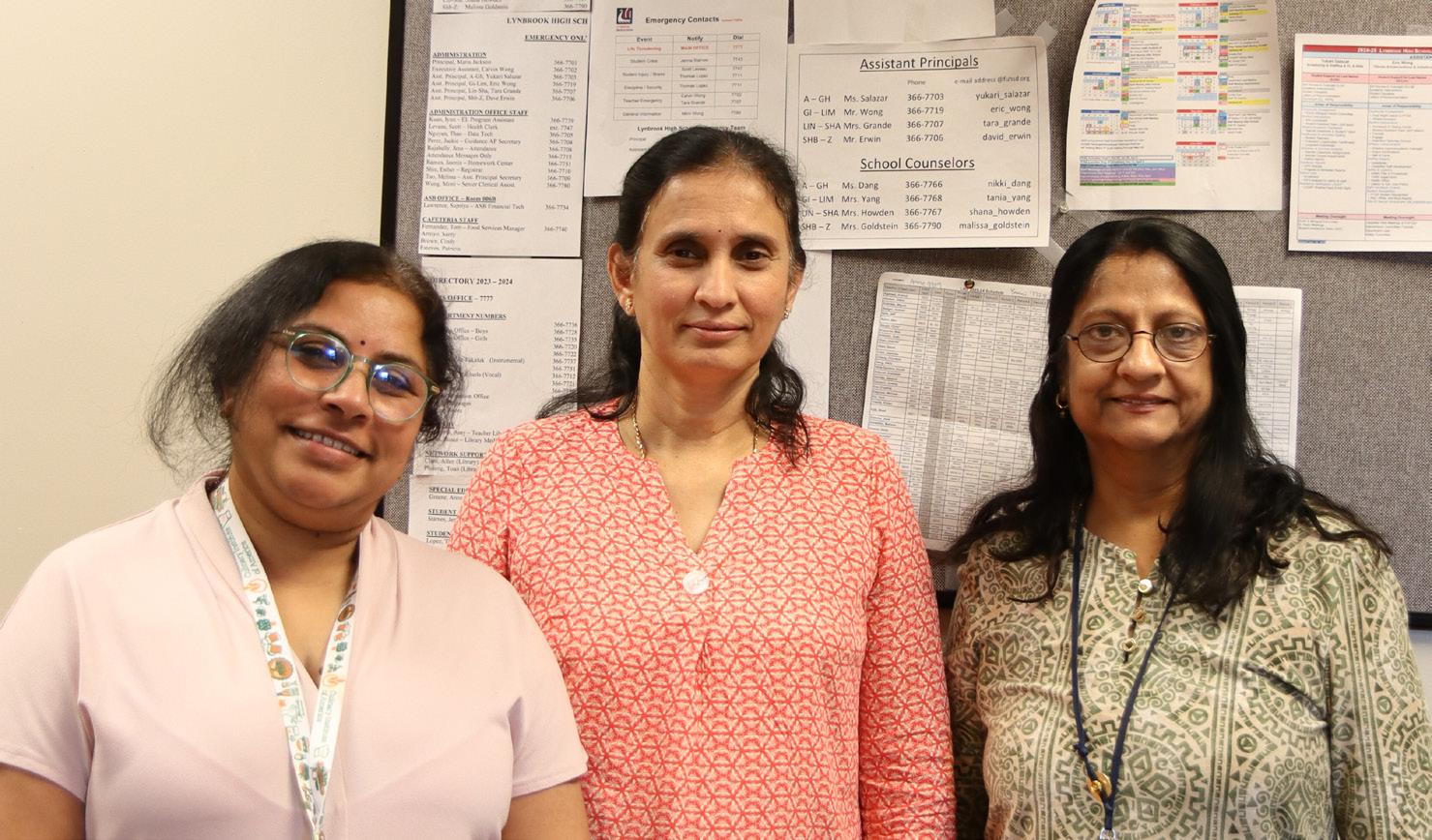

Saxena was inspired to join the district as a paraeducator after her children attended Lynbrook. Previously a teacher of fve years in India, Saxena was interested in understanding the different education system her children were in, pushing her to volunteer in their classes.
“I really wanted to come here,” Saxena said. “Both of my kids studied here; I have ties, neighborhoods and history here. It’s so fulflling when I take my evening walks and see students in the neighborhood — they recognize and wave to me.”
She often asks herself questions integral to student success: Are they falling behind? Do they need to retake or not? What can we do as paraeducators?
Because of these demands, she is appreciative of the respect she receives from both students and teachers.
“There is so much inclusivity because the teachers portray us as just another teacher in the class,” Saxena said. “We love when students, regardless of their program, reach out to us and ask us questions.”
Growing up in a boarding school, Narasimhan, one of Lynbrook’s resource paraeducators, was constantly surrounded by a learning environment. Eventually, that sparked her interest in working with students and brought her to foster this environment everywhere she went.
“I was in school all the time until 10th grade,” Narasimhan said. “Because of that, I became comfortable around students and school communities. So even when I came to America, I was drawn to volunteer at a school. That eventually developed into a full-time job, and it has been 18 years since.”
The Academic Community Transition program works alongside the Student, Opportunities, Achievement, Responsibility program, a post-secondary program that aids students who will earn a certifcation of completion or alternate diploma. Once they complete high school, they continue their education in SOAR until they are 22 years old. One can fnd Lynbrook’s ACT and SOAR paraeducators at local stores supporting students as they practice life skills including making purchases, or around the 600 wing, actively assisting their students.
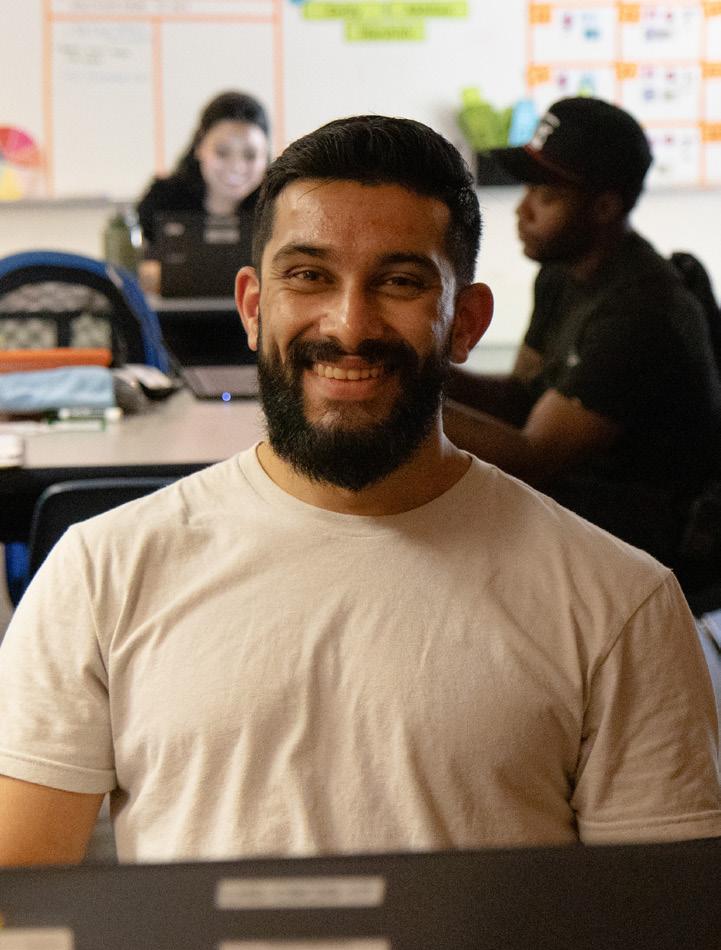
Walking to Safeway with students isn’t a typical exercise teachers conduct at school, but it is for Khandekar. Since 2022, Khandekar has worked with Lynbrook’s special education department. Starting with meetings in the early morning and late afternoon, Khandekar and his colleagues work hard to ensure Lynbrook’s special education students are receiving the support they need.
Years after Khandekar attended Monta Vista High School, he still remembers the inspiration he took from his wrestling coach, who was both a mentor and a paraeducator.



The job can be tough — working seven hours a day and hosting after-school offce hours to provide extra help for students. Despite this, Narsimhan fnds fulfllment in her job as she watches her students learn and succeed.
“You really become attached to the students, whether you like it or not, and watching them grow everyday gives you and then leaving for college is the best experience,” Narasimhan said. “It makes you want to be at the center of giving them that support.”

“He made me realize that there are non-traditional teachers on campus that too work with students,” Khandekar said. “Seeing my coach enjoy his job gave me a really positive impression of paraeducation. It showed me that there are more paths in education than just teaching.”
Khandekar studied journalism in college, and when he returned, he learned about an opportunity in paraeducation while catching up with his old district friends. Jumping at the job opening, Khandekar began as a paraeducator substitute teacher at Lynbrook, and now works as a full-time, differentially-trained paraeducator.
— even when we’re just talking to our students — and provide them with the necessary
BY REBECCA CAI
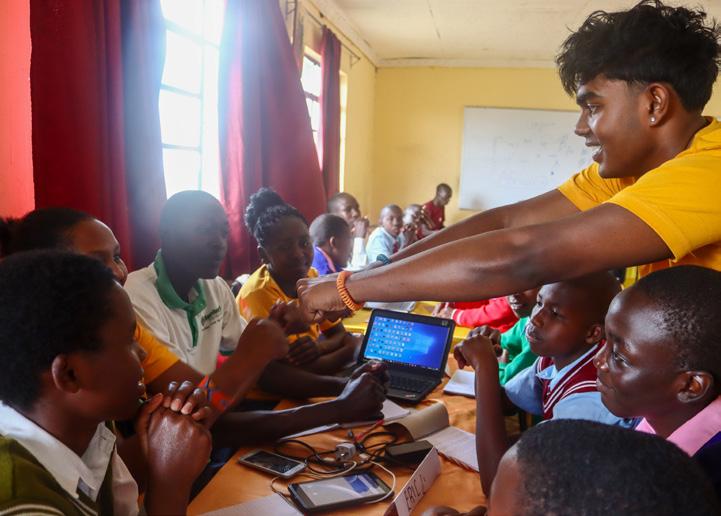
In a warm and energetic classroom, seniors Nishchay Jaiswal, Arnav Shah, Sriya Sthanikam and Sanaa Gada draw excitedly on whiteboards as they teach a group of students from the Kenya countryside. As members of the nonproft organization CS4ALL, the seniors traveled across the world to bring the gift of programming to underprivileged students from the Kenya countryside.
Co-founders Jaiswal and Shah created CS4ALL in 2023, yet, the idea behind CS4ALL started much earlier. Throughout middle school, Jaiswal ran a computer science club at William Faria Elementary School, and he wanted to expand its impact.
“In junior year, I realized we were running a CS club at one elementary school, so I asked myself why not do it at others?” Jaiswal said.
During Jaiswal and Shah’s junior year, they established CS4ALL, which now partners with local elementary schools such as Dilworth Elementary School. However, the two seniors wanted to extend their infuence further beyond the borders of the United States and across the ocean, to Maralal, Kenya.
This project, known as CS4AFRICA,
is a partnership with the Asante Africa Foundation. Asante Africa offered CS4ALL the chance to go global — one that the seniors eagerly took.
“Asante Africa’s theme this year was digital literacy,” Shah said. “That fts really well with CS4ALL’s mantra. I pitched the idea to the CEO by email, and she thought our idea sounded interesting and wanted to talk more.”
Once Erna Grasz, the CEO of Asante Africa, accepted the idea, CS4AFRICA was offcially in action. Taking place from Aug. 4 to 9, CS4ALL ran a 5-day bootcamp. They taught a variety of topics including Scratch, Python and other basic computer fundamentals. They not only instructed students, but passed their knowledge onto teachers to increase the impact they left behind.
“
You can teach fve teachers who can teach 100 students each. Now you’ve impacted 500 kids’ lives.
Nishchay Jaiswal Co-founder of CS4ALL
“
The students, some arriving after multiple hours on buses, gathered and met with their bootcamp instructors. Despite the socioeconomic, language and ethnic differences, the students quickly bonded with their teachers.
“Our frst experience with them was playing basketball,” Shah said. “It completely removes all the potential tension that there could have been. They were nervous at frst, but we did our best
to incorporate them into everything, and it was really fun.”
The bond between student and teacher only continued to grow. Each morning, the boot camp began with energizers, consisting of dancing, musical chairs and more. It started each lesson with high energy and engagement, setting the beat for the rest of the day.
“I taught them games like musical chairs and charades,” Gada said. “I wanted to show them that education is so much more than reading a textbook. The best way to learn a new concept is if you’re having fun doing it, and it’s the teacher’s responsibility to make a new concept feel approachable.”
CS4ALL also structured competitions to encourage creativity in their students. On the last day of the bootcamp, each student presented their project to the board members of Asante Africa.
“They enjoyed working in teams
and even wanted to win the competitions we gave them,” Sthanikam said.
CS4ALL hopes to continue their global outreach and impact, even after Jaiswal and Shah graduate and hand off their duties.
“We are looking to other organizations, so that we can run this a second year in a row,” Shah said. “In the future, we hope to expand to multiple countries.”


BY LILLY WU
At a venue in front of the Great Sphinx of Giza, senior Brian Xue received the title of thirdplace winner at the International Olympiad in Informatics. Despite the intense competition, his face, illuminated by the large lights above, glowed with a smile while he retrieved his medal in front of hundreds of spectators.
Xue coded for the frst time when his elementary school offered a class teaching the basics of Turtle, a feature in Logo that allows users to “draw” using code. Two years later, he learned his frst programming language, Python, using a self-study course online. As he got older, he became skilled in HTML, CSS, Java, JavaScript and C++.
“Although I self-learned a lot of the languages I know, I learned C++ from my family friend and Java from the AP Computer Science A class at Lynbrook,” Xue said. In sixth grade, Xue began competing in the United States of America Computing Olympiad, a national competition. He was promoted to the gold division in a few months, but soon struggled with moving higher.
“I hit a massive brick wall where the problems suddenly became very hard, and I was very disappointed with my lack of progress,” Xue said. “I felt like I could pursue other paths, so I switched tracks to do competitive math.”
Fortunately, Xue picked coding back up again at the end of eighth grade during the COVID-19 pandemic. Inspired by his friend who was doing well in USACO, Xue decided to give his old hobby one more try.
“My friend was improving very quickly, and I hoped that I could get better too,” Xue said. “Part of the reason was also because I missed coding, and competitive math got boring for me.”
To hone his skills in programming, Xue went to X-Camp Academy, an institution preparing students for coding competitions. Xue participated in the program the summer before his sophomore year, where he worked on many coding problems along with other students. For the entire summer, Xue practiced from 9 a.m.- 5 p.m., which contributed a lot to his improvement.
Soon, Xue was consistently scoring well in USACO’s platinum division. Due to his success, Xue was selected to participate in the USACO training camp the summer before junior year. At this camp, students continue to practice coding, and four students are selected to represent the United States at the International Olympiad in Informatics. Despite not being chosen that year, Xue participated in the training camp again the following year and was successfully selected.
“ “ I am really satisfed with my journey in computer science, and I wouldn’t trade it for anything.
“Not only did we travel, but we also got to talk with a lot of new people, including the members of teams from other countries,” Xue said.
The frst day the team arrived in Alexandria, they attended the opening ceremony. The competition itself consisted of two days, with the competitors solving three problems in fve hours each day.
“I felt immensely pressured during the competition,” Xue said. “It was very stressful because our entire team was so jet-lagged from the fight. While the competition lasted for fve hours, I only had enough energy to compete for three hours of it.”
Despite being the only member on his team without prior experience, Xue placed third in the competition, making him frst place in the United States.


“The camp would rank the students from tests that we took,” Xue said. “This summer, I was in fourth place, so I got to go to IOI.”
This year’s IOI competition was held in Alexandria, Egypt and lasted from Sept. 1 to Sept. 8. While traveling there for the competition, Xue and his teammates also visited Cairo to see the Giza pyramid complex and the Egyptian Museum.

“When I found out, I was very shocked and just in disbelief,” Xue said. “I was hoping for somewhere around 15th place or even the top ten if I got lucky, but I was not expecting to be third place in the world.” In the future, Xue plans on continuing his programming journey by pursuing computer science as his career.
“I am really satisfed with my journey in computer science, and I wouldn’t trade it for anything,” Xue said. “I got to meet so many cool people that I wouldn’t have had the chance to meet otherwise, and the experience has improved my skills in different areas.”
BY IRENE HWANG AND STUTI JAIN
San José and Cupertino have forged connections with a multitude of sister cities fostering social and political connections worldwide.
In hopes of creating global goodwill after World War II, Sister City International became offcial in 1956.
In 1957, San José became the third city in the United States to have a sister across the globe: Okayama, Japan. San José has signed seven sister city agreements, the latest in 1992 with Ektarinaberg, Russia. Similarly, Cupertino has expanded its horizons, establishing its frst relationship with Copertino, Italy in 1963, and most recently with Bhubaneswar, India. Building these connections, San José and Cupertino have raised cultural awareness about different communities around the world.
San José holds an exchange program with Okayama, Japan, where students from both cities spend a week with a host family in the other city. During COVID-19, the three exchanges were held virtually. Alumni and students from both cities held conversations and performed a skit about their hometown and culture. In the summer of 2024, six students from two high schools attended an inperson exchange.
“
I can say with certainty that the students who visited Okayama this summer were excited and happy and would visit again in an instant.
Kathy Sakamoto
President of the San José-Okayama Sister Cities
“
San José maintains relations with Dublin through programs such as a Shamrock Run. Each February, SJDSCP also organizes an annual Irish Week, where San José hosts a political delegation from Dublin.
The Cupertino-Hsinchu Sister City Association and Cupertino-Toyokawa Sister Cities organize exchange programs annually where each student from Cupertino is assigned a host student and family in Hsinchu, who they live with for the week-long program.
“I called my host student beforehand to get to know her better, so the frst day we met, we just really clicked,” junior and participant Natalie Tan said. “I learned a lot from the family I stayed with; they taught me the meaning behind each of the historical sites we visited.”
Tan keeps in touch with her host student and looks forward to experiencing Halloween together in the U.S. when they visit.
In 2019, the Cupertino-Bhubaneswar Sister City Initiative agreement was signed. Co-founder and president Reena Patnaik Rao explained that after pitching the idea of a new Sister City program to the mayor, hours of planning and two trips between the cities, the idea was approved.
In 2019, CBSCI started its exchange program, in which students from the city came to Lynbrook to experience Cupertino culture. However, due to the pandemic, no more trips have been held. The program will resume in the spring of 2025.
Although the pandemic created obstacles for the sister cities, the Cupertino programs adapted.
“COVID-19 gave us the opportunity to sort of look
back, and then try out new things to continue to learn from each other,” said Angela Chen, CHSCA president and high school and city liaison.
CBSCI also held a virtual symposium in hopes of sharing each city’s knowledge. In the interview, Rao said that the symposium brought together people to discuss topics including disaster-management and the arts industry, aiming to foster a global exchange of ideas.
“Because of COVID-19, a lot of poor people in India were suffering,” said Mahesh Pakala, executive board member of CBSCI. “So we thought this would help in creating that bridge, creating more opportunities.”
For decades, the sister cities championed a mission: getting the younger generation involved to keep global relationships thriving.
“By participating in the cultural exchanges, students learn a different culture, experience a local language and make lifelong friendships,” Chen said. “If we can allow more students who don’t have an opportunity to go, that would be amazing.”

BY ALEXANDRA WU AND CECILIA WU
Food imperialism is defned as one culture infuencing another culture’ food practices, including traditions, preparation methods and consumption. This phenomenon often occurs through colonization, globalization or other methods of cultural exchange, leading to the adoption of certain foods or culinary practices at the expense of local traditions. While it can spread new favors and techniques, it may also lead to the erosion of indigenous food cultures.
Through close examination of trading patterns, global palates and current eating habits, it is evident that food imperialism has affected culinary culture worldwide.
From Ceremonial Tea to worldwide refreshment

Although tea is often associated with European aristocracy, it originated from China where it quickly became a favorite around the 3rd century. In the 9th century, traveling Buddhist monks brought the drink to Japan, adopting it into the culture.
In Europe, the Portuguese princess Catherine Braganza’s interest in tea made it a fashionable beverage in the upper class, spiking its demand.
Groups like the East India Company exploited the cheap cost of tea from India to Britain, shifting trade away from China and colonizers reaped the economic gains at the expense of colonized populations.
Tea was incorporated into social rituals, such as the British tradition of afternoon tea and Japanese tea ceremonies..
Throughout many cultures where tea is found, traditions have been adapted to each region’s tastes. In China, tea focuses on the aroma and subtle aftertaste of the tea. Popular teas in Japan include matcha and sencha, known for unique preparation rituals and umami aftertastes. In Korea, barley and various herbal infusions brought out nutty aromas.
In South Asia, tea is commonly enjoyed with milk and spices like cardamom and ginger, , which refects the region’s culinary traditions, where spices are integral to everyday life.

Tea gradually spread across continents, and continued to adapt to its regional favors, making it a dynamic part of modern-day contemporary food culture.
“Sugar consumption increased with the rise of the plantation system and increased popularity of teas,” Nguyen said. “I would say that the milk tea people enjoy today is a product of many years of culture and infuences coming together under British colonialism in Asia.”

The evolution of spam from war bunkers to pantries
Spam is known as an ingredient used in modern cooking, but it began as a source of protein for American soldiers during World War II. Due to its long shelf life, spam rose in popularity, spreading to regions where troops were stationed. Spam lingered in places suffering from food shortages during post-war reconstruction efforts. It was introduced to the Philippines during the Japanese invasion when food rationing made spam a necessity in the Pacifc Islands.
“What we can see happening through imperialism was the United States viewing itself as superior in its relationship and the initial relationship that it built with the Philippines and places like Hawaii,” history professor Lindsay John Bell said. “The colonizer believes they are superior to those being colonized.”
During the Korean War, Korean soldiers ate army stew, or “budae jjigae”, which featured Spam, which fused local ingredients with American elements.
Soldiers stationed in Hawaii brought excess amounts of Spam, which spread into local trade, infuencing local cuisine, creating foods like Spam musubi.
Stigma developed against Spam in Western countries like Britain and America, leaving its mark on language through modern slang. Unwanted mail is referred to as ‘spam’, refecting the unappealing nature of Spam in Western culture.
By contrast, the cost of importing from the West made the item expensive in the East, elevating it to a luxury status.

The roots of chocolate can be traced to the Aztecs before the 16th century, a civilization located in Mesoamerica that used cacao beans in their monetary system. Cacao drinks were used during celebrations and marriages as they were thought to be divine.

The fruit was introduced to Europe by Hernán Cortés during the early 16th century when they encountered it in the Aztec Empire during their conquest of the Americas. The Spanish initially saw cacao as a bitter, frothy drink and shunned it as a drink for pigs. Over time, the Spanish experimented with the drink, adding sugar and spices. Historical accounts claim that King Charles V of Spain enjoyed it so much that the drink became associated with status, leading to its popularity.
“There’s this idea that since imported goods are more expensive than local goods, you would have to be rich enough to afford imported goods,”
history teacher Luca Signore said. “If you could afford them, you would be considered rich.”
By the 17th century, chocolate houses became fashionable social hubs for the wealthy in Madrid and Paris, reinforcing their status in high society and European culture. Today, chocolate has taken on various forms worldwide, from easily accessible hot chocolate and grocery store stuffed chocolate bars, to luxuwriously decorated chocolates made for gifting.

BY QIANZI LOO AND KIERAN HAU
What once took form as old piles of political newspaper ads have gradually transformed into versatile digital formats, marking a new era of politics as younger voters promote ideologies online. Over the course of history, youth activism has been critical in placing meaningful pressure on traditional political parties or structures. Yet, despite record-high young voter turnout of 55% in the 2020 presidential election, there has been growing concern of apathy among them. Based on statistics from the United States Census Bureau, voters between the ages of 18 to 24 still have the lowest percentage of voter turnout.
“The young voters’ vote constituency isn’t the largest by any means, but I do believe that the percentage of young voters is increasing just when comparing them over the years,” said Brittany Adams, Department Chair of the Humanities and Professor of History and Gender Studies at Irvine Valley College. “So the more that students vote, I think the more their issues are going to get attention.”
There are traditionally two main political parties people identify with. These parties often face little incentive to reform, but the emergence of third parties —
Civil Rights Movement: This movement aimed to abolish segregation and discrimination. Young people conducted sitins across the country and organized activist committees, contributing greatly to the revolution.
often driven by young voters — can change this dynamic.
For instance, the Green Party places emphasis on environmental activism and social justice, serving as a viable alternate option for young voters who feel disillusioned by the current political system. For the 2024 presidential election, the Green Party has endorsed Jill Stein as their presidential candidate, a physician and activist.
Historically, the Green Party gained traction among young voters in the 1980s. It wasn’t until the election of 2000 between George W. Bush and Al Gore that Democrats and Republicans took notice. If Green Party voters in Florida had voted for Gore, then Gore would’ve won. Thus, while young voters or third parties themselves have little chance of winning, they still hold signifcant power in swing states.
“In states where it’s like 45% Democrats and 50% Republicans — and you just need to get over 51% — that 6% of people really matters,” social studies teacher and department chair Steven Roy said.
Young political activists have made up for their lack in numbers with powerful spirit and rhetoric. Dating back to the Vietnam War from the 1960s to 1970s, young adults organized anti-war protests on college campuses upon seeing the relentless disaster in Vietnam for both American and Vietnamese citizens. Their efforts gained the traction of media outlets. Former President Richard Nixon took advantage of this momentum to appeal to more voters by promising to pull out of the Vietnam War and conduct peace negotiations.


Black Lives Matter:
Began after a black teenager was shot unjustly by a white police ofcer, later rising to prominence with #BlackLivesMatter. Youth throughout the country have led protests targeting antiblack injustice.
Vietnam War Protests: Young adults organized anti-war protests on college campuses because they believed the war was wrong. Their eforts quickly gained traction in the media, spreading throughout the country.
Youth involvement in politics has extended to concern social structures impacted by various new laws as well. Such was the case during the Black Lives Matter movement, which was popularized in 2013 and advocated for racial equity for black Americans. As the issue of systemic racism progressed, young Americans drove widespread calls for police reform to pressure local police departments into reforming their offcer training curriculum. Once thought of as impossible, police offcers started to face serious repercussions for their actions in some instances.
“
I have never met a young person who doesn’t have some issue that they’re passionate about. Yet, there’s been a bit of a gap where there are young people who are interested in issues, but they don’t necessarily see a political landscape that’s paying attention to them and valuing their voice.
Jessica Stamen Program Director at Democrashe


Women’s Rights Rally: After a leaked draft showing Roe v. Wade’s overrule in the Supreme Court, protests against the restriction of reproductive rights occurred throughout the nation. To protest, Lynbrook students participated in a school rally, marching with signs and giving speeches.
As the 2024 election campaign nears its fnal stretch before election day on Nov. 5, young voters and politicians have used social media as an opportunity to engage more of their community. In particular, the campaign of Vice President and presidential candidate Kamala Harris has taken the internet by storm with various trends and memes, which largely appeal to a younger audience. These include her quote saying, “You think you just fell out of a coconut tree?” — which was originally mockingly used against her by Republicans, but she later embraced the quote. Celebrities have also used their massive online presence to endorse their favorite candidates, such as British pop singer Charli XCX and American pop singer Taylor Swift.
Likewise, former president and presidential candidate

In 2021, the youth of Pittsburgh, a part of the Green Party, organized a climate strike and march, advocating for a shift from fossil fuels to regenerative energy.

July 4, 1974,
Donald Trump gained sympathy from the public following his assassination attempt in July 2024 at a rally in Pennsylvania. Through social media, images of his fst raised immediately after the shooting, evoked a sense of patriotism and unity amongst his voters.
James Nguyen, instructor and political science department chair at De Anza College, said in an email interview with the Epic that while social media exposes students to diverse perspectives and encourages engagement, it can also create echo chambers that deepen polarization. In his classes, he has seen this polarization refected in his students, making class discussions more intense, prompting shifts in his curriculum that focus more on critical thinking and media literacy, delving into real-world issues with an analytical lens.
“Social media users tend to phrase stories in a way to get you to believe what they believe,” junior Ishana Subrahmanyan said. “Social media, based on what kind of media you consume, can really infuence one’s political opinion and stop people from forming opinions of their own.”
While conventional news were reporting channels and newspapers, the increasing integration of technology in the modern world has allowed for more alternative sources of information; most notably on social media platforms such as Instagram or Tiktok, which can be far more attractive to youths less inclined to sources such as news articles.
“How I started caring about politics was seeing on social media all the bad world events that we should know about,” senior Evan Lu said. “I get really bored by the news, but social media is optimized for maximum engagement and makes it easy to learn about information because I am actually engaged. A lot of younger people use social media, and it is a good space to be exposed to more ideas.”
As a general trend, young voter turnout has increased consistently. While their motives for voting have shifted from the fear of getting drafted for war during the 1900s to concerns over personal liberties, their infuence and youthful spirit have remained the same.
“I think it’s important for us to be aware about politics,” junior Sanika Vaidya said. “People sometimes say ‘I don’t really care about politics’ — but that’s not helpful, because we’re the ones who are gonna have to deal with this in the future, so we should know what’s going on.”

BY MADDY CHANG AND ROHAN KAKHANDIKI
Beneath the heat of a relentless Southern sun, shackled hands work tirelessly in the felds; backs straining against the weight and echoes of slavery in the modern day. The Thirteenth Amendment is often seen as a law that completely abolished slavery, yet a loophole remains: allowing slavery to remain legal as a form of punishment.
In November, California will vote on Proposition 6 — a measure that would remove this exception from the state constitution. California is one of 16 states where the constitution’s wording remains.

Written in 1864, the 13th Amendment outlawed all forms of slavery “except as a punishment for crime whereof the party shall have been duly convicted, shall exist within the United States, or any place subject to their jurisdiction.”
The Amendment excludes labor protections for incarcerated workers, including workplace safety regulations and minimum wage. Many believe the loophole served as a way to convince offcials from both the North and South to support the amendment, drawing language from similar slavery documents at that time, such as the Northwest Ordinance of 1787.
“I think the intention of the amendment was basically, ‘we need labor and we also need to control black people,’” said Libra Hilde, Chair of San Jose State University’s History Department. “They didn’t like emancipation and didn’t like the end of slavery, so they needed external control to keep black people at the bottom of the social ladder, and the way to do that was through the justice system.”
Chattel slavery, a system in which individuals were permanently owned as property, was a race-based form of slavery that became extremely common in the Americas after European colonization. Enslaved Africans were
transported across the Atlantic and sold to meet the demands of colonizers, who had seen a sharp decline in their Indigenous labor forces. Chattel slavery is distinct from other forms of slavery because chattel slaves and their children had no means of escaping the system. This form of slavery was almost exclusively applied to Africans.
Even though slavery became a more prominent feature in American economics by providing necessary labor for the agricultural industry, support for the abolishment of slavery through political activism and advocacy eventually overpowered the dissent. Yet, the institutional struggle against forced labor continues in the 21st century as the prison industrial complex perpetuates a form of modern-day slavery through inmate labor.
In addition to free prison labor, the loophole laid the groundwork for exploitative systems like Black codes and convict leasing in the 1860s. Black Codes criminalized actions like “rude gestures” or “mischief” and were used to target African Americans. The result was an overrepresentation of in Black people in the prison system, with 33.3% of the entire prison-population being Black, with only 13.6% of the overall population being black. Later, a convictleasing market in Southern States was established, in which inmates were leased to private companies by the government. In the 1871 Supreme Court Case of Ruffn v. Commonwealth, courts ruled convict leasing to be legal and deemed those incarcerated to be equal to that of an enslaved person.
“Slave labor, and not paying what people are worth, in terms of their work, is something that is fundamental to capitalism,” said African American Studies Professor at De Anza College Dr. Julie Keiffer-Lewis. “In particular, folks who do the menial labor have historically been those of marginalized identities,

whether that’s an immigrant, person of color or women. The system of inequality affects where these folks can work and their funds.“
Today, the rise in prison labor refects the same patterns. States leasing prisoners for agricultural labor has been an ongoing problem in the 20th century, providing farms with labor in the form of inmates. The monetary incentive behind mass incarceration allows the effects of Black codes to exist — even in the modern day. According to a study done by the Associated Press, over $200 million dollars were amassed in the agricultural industry from prison labor alone. Inmates are used for labor-intensive farm work to grow crops like onions, apples and tomatoes. Prisoners, in some cases, receive zero compensation for their work, even though they produce roughly $11 billion annually for prison systems.
In April of 2024, a lawsuit was fled against the company Aramark for not compensating their prison work-force. The California Supreme Court ultimately dismissed the case, deciding that the company was not required to compensate the workers when there are no minimum wage laws protecting the prison labor force.
In addition, inmates are often the victims of harsh work-environments, including facing exposure to harmful chemicals and extreme temperatures. Those who refuse are subjected to punishments like solitary confnement, denial of reduced sentences and more.
Samual Brown, a member of the prison work-force during COVID-19, said that prisons could strip inmates of cell phone privileges, visitation rights and the power to order one’s own food during an interview with CalMatters.
“At the end of the day, it was individuals and groups of people who made the decision to weaponize the loophole and use it against formerly enslaved people,” said Michele Bertelone, American History Professor at De Anza College. “It’s a failure of the system and failure of the morals of the people involved.”
Examples of prison labor include inmates being forced to fght fres, making up 30% of all wildfre fghting forces in California, creating back-to-school furniture and agricultural labor — paralleling chattel slaves who predominantly worked on farms. According to the Federal Bureau of Prisons, inmates are paid 12 to 40
cents per hour for a single assignment. Despite the low wage, a signifcant portion is still taken and used to fund the country’s Criminal Justice System, preventing inmates from saving up any substantial amount of money.
A more notable aspect of prison labor is the involvement of mainstream corporations. Companies like Amazon, Home Depot andFedEx all use forced prison labor; many popular food brands have been found to use prison labor to make products as well. Inmates are actively involved in making every-day goods, highlighting the far reach of the prison-industrial complex.
“Now, for-proft companies are getting paid by the government to manage much of the prison system, and those companies are also, to some degree, able to beneft from prison labor,” Bertelone said. “Here, we can see the intersection between commerce and the penal system.”
In 1971, The Attica Correctional Facility in New York was taken over by prisoners, who demanded the right to form a union and minimum wage payment. Although the city did agree to meet some of their demands, such as providing access to higher education and religious freedom, their call for increased wages were not met. More recently, prison-laborers across the country protested in 2018, calling the prison system ‘modern-day-slavery’. Deemed the largest strike in U.S. history, prisoners made a list of ten demands including voting rights and removal of free prison labor. None of the demands were met and prisoners were punished through prison transfers and solitary confnement.
Beyond the issue of prison labor, the challenge of recidivism remains. servitude as punishment for a crime,



BY CRYSTAL ZHU
Feet swipe, royal scarlet fabric faps and spear points slice through the air as junior Esther Kwan fies across the mat. She sticks another “mabu,” or horse stance, a special squat used in Kung Fu. Ignoring the sweat on her palms, she shifts the grip on her spear as she moves through her routine, executing a kip-up followed by a series of kicks. Key Chun Song, her “shifu”, or master, watches from the sidelines as the culmination of 10 years of training comes together in her pursuit of the gold medal. And, in her second pan-American competition, Kwan received that honor.
Over the Labor Day weekend from Aug. 31 to Sept. 1, Kwan arrived at the Santa Clara Convention Center to compete against traditional Shaolin Kung Fu athletes from Argentina, Brazil, Canada and more in the 14th Pan American Wushu Championships, where she represented the United States along with her fellow teammates. Kwan participated in four routines with a spear, a chain whip, daggers and the Seven Star boxing form.
“It was a really exciting experience,” Kwan said. “But I’m somewhat disappointed about my Hand Form performance at the competition because I lost balance, which cost me gold in that category.”
The results were joyous for Kwan: she had received gold for Northern Style Long Weapon, silver in both Shaolin Chain Whip and Shaolin Barehand and bronze in Shaolin Short Weapons. Kwan was pleasantly surprised — Shaolin Chain Whip was not her strongest form, but focused training on the routine gave her leaps and bounds of improvement.
“I was very happy and fulflled at the end of this competition,” Song said in a translated interview. “The road from a little girl to a Kung Fu champion wasn’t easy; there had been pain, tears and a lot of sweat. But everything was worth it, she did it and she succeeded. As her shifu, I’m very excited and proud of her.”
Her success was a result of a long story. Kwan frst stepped onto the now-familiar mats as a 6-year-old. Having already sampled Karate, Kwan ultimately settled on Kung Fu, intrigued by the unique weapons.
“We went to a Kung Fu performance when I was six,” Kwan said. “I saw all the tricks, kicks and Kung Fu weapons that I hoped I could learn in the future.”
The pandemic was an especially transformative time for Kwan. Prior to the lockdown, Kung Fu was simply a hobby for Kwan. Yet stuck at home with nothing to do but join Zoom Kung Fu classes, she worked on her own technique while observing others. Zoom practices soon became team practices in the park, and her improvement sped up.
“My teammates and competitors from other studios and countries are setting the bar higher, which encourages me to do better,” Kwan said.
Her teammates and shifu encouraged her training. Whenever she needed assistance, Kwan’s shifu would offer her feedback on her form and technique. Before competitions, Kwan increased her practice to several times a week, with each class tailored to a specifc form. This helped Kwan hone in on separate routines every class — the spear for one, the chain whip for another.
“She has great leadership skills, is kind and caring and helps other people,” sophomore teammate Allison Chew said. “She is focused and hardworking, but is also carefree and fun to be around.”
Despite her success, the journey has not been without bumps and bruises. Kwan sustained a shoulder
injury two weeks prior to her last Pan-American Kung Fu Competition in Canada. Despite soreness, Kwan attained second place.
“My shifu and teammates always encourage and push me to do my best,” Kwan said. “They would always point out ways that I could improve. When I injured my shoulder last year, they helped me fnd ways together to perform the moves without causing more harm to my shoulder.”
Even after graduating, Kwan will continue her lifelong passion through college martial arts clubs and international competitions. Yet, as far as she goes, she will never forget or fail to keep in touch with her teammates.
“I’ve learned to be open to failure and mistakes,” Kwan said. “It may take a while to improve but I’ll always fnd a way to succeed.”
BY ANNA CEN
Recent spikes in high temperatures have caused Lynbrook athletes to hesitate before lacing up their running shoes or strapping on their gear. A string of 80-100 degree days has made spending time outside a struggle, and exertion often unfathomable. In light of a California policy banning outdoor sports in

and games must be postponed, canceled or moved indoors. The policy expresses that if temperatures exceed 86.2 degrees Fahrenheit on the WetBulb Globe Temperature scale, a measure of heat stress in direct sunlight while taking humidity, wind speed, sun angle and cloud cover into account, sports activities must be canceled or moved. Additionally, if the Air Quality Index level rises to above 150, no outdoor practice, workouts or matches are allowed and must be delayed until safer conditions are reached. The Centers for Disease Control and Prevention reports that each year, heat illness is one of the leading causes of death among student-athletes. The effects of these dangerous environments are high among student-athletes who spend several hours a week engaging in rigorous outdoor exercise, especially athletes with pre-existing health concerns or those who wear heavy gear.

Farenheit was the average high tempertaure in August in California
“The gear traps the heat inside your body and makes it seem hotter than what is really stated,” sophomore and varsity football captain Owen Huang said. “Our gear makes the overall situation reach a whole other level.”
Current Lynbrook policy regarding outdoor sports in harmful environments varies from team to team. While some outdoor sport activities in these hazardous environments are postponed, a few large-scale events that can’t be canceled require student-athletes to perform high-exertion activities in sweltering heat and suffocating air. Rather than being canceled or rescheduled, many games and practices are simply shortened.
“During a tournament, it was 100 degrees Fahrenheit with bad air quality,” senior and varsity girls tennis captain Kylie Liao said. “Our sets were shortened, but even then, my opponent was red in the face and gasping for air. This was an instance where the organizers should have prioritized player safety and canceled.”
An important factor to be considered is pre-existing health problems student-athletes have that could be amplifed in extreme heat or harmful air quality. Students with conditions, such as asthma, are placed in much higher risk in these kinds of dangerous environments. In these cases, it is important that all student-athletes are aware of these situations and are able to fnd support for them.
When we see bad air quality or high temperatures, it’s a reminder that we need to be careful and look out for our teammates. Everybody has different needs and reactions to the weather, so we need to check in on people and make sure they’re okay.
Kylie Liao
Senior and tennis team captain
Currently, Lynbrook athletics uses temperature and air quality gauges to determine the risk level of the environment. Additionally, many student-athletes discuss with their coaches to determine when practices should be canceled. A good consensus is reached where both student and coach opinions are considered.
“Our coaches are considerate about the conditions because they’re all former football players, so they’ve all experienced how bad conditions can impact athletes,” senior and varsity football captain Justin Kim said.
While some sports implement the CIF and school policy very strictly, other student-athletes are less aware of its details. As many student-athletes report, they often don’t realize exactly how hot temperatures are or how bad the air quality is. By the time symptoms of heat illness or bad air quality appear, it may be too late to take action.
Ensuring that student-athletes and coaches are aware of available resources and rescheduling according to the environment is crucial for their health. In addition to providing more shade, proper education regarding hydration, hazardous air quality and recognizing signs of heat illness should be a part of student-athlete learning. Coaches should also communicate consistently with student-athletes when high temperatures appear in the forecast in order to support them.
“There’s never a game that’s ever going to outweigh the level of risk of heat illness or bad air quality,” athletic trainer Scott Leveau said. “Safety always comes frst.”
BY AKASH ANAND AND ANGELINA FENG
At a Lynbrook Vipers Cricket Team practice, sophomore Sreyes Chetput winds up his arm to throw the ball as senior and captain Ayaan Khan prepares to strike. Seconds later, it surges through the air, slamming into Khan’s bat with a solid crack, then arcs back into the hands of senior and captain Aarav Jani. Cricket, originating in England, was later popularized in South Asia, England, Australia and the Caribbean, and has recently gained popularity in the United States. Cricket is played between two teams of 11 players each. The feld contains two vertical stumps crowned with horizontal sticks, called wickets, at the center, and each team aims to get the most runs either by running the 22yard stride from one wicket to another or hitting the ball past the edge of the feld to score six runs and within the feld boundary to score four runs.
Each cricket team includes a bowler, the player that throws the ball to the batter; several outfelders who catch and retrieve the ball and a batsman, the player who hits the ball into the outfeld.
“It’s hot so it gets pretty blurry, especially when the ball comes super fast,” freshman and batter Savya Churi said. “A player bowls high, so it’s like a bullet coming at you.”
The Vipers Team was founded in December 2023
unoffcial six-team league. Matches regularly take place at Cupertino Library, Dilworth Elementary School and Lynbrook. In addition, the captains hold informal practices outside of games, strengthening bowling, batting and felding skills, while fostering collaboration among a team of varying experience. Since more experienced players have been on club teams with professional coaches, they host training sessions for the others to improve.
“It’s nice to understand the strengths and weaknesses of different people and learn how to adapt to them,” junior Bruhath Batla said. “For example, someone might be good at bowling, but struggle with batting. Additionally, a lot of our teammates are new to cricket, but they said, ‘Why not join? I’ll try cricket for some time.’”
Despite not being an offcial school sport, the time commitment for the Vipers can be upward of 10 hours per week. This can impede players from joining, especially if they are participating in other extracurricular activities. Moreover, because the team lacks a concrete season schedule and a coach, the captains need to personally contact a variety of unoffcial teams in the Bay Area to schedule matches.
“If you play on the Vipers, you spend just as much time as other school sports, maybe even more,” Chetput said. “If we do get introduced as a school sport, players are at least getting credit for the amount of hours they

Many players, including Jani and Khan, attribute cultural and familial infuences — often from individuals like parents or grandparents — for their introduction to the sport and motivation to play for the Vipers. Cricket is an extremely popular sport in India, with over 600 million viewers watching the sport through television or other streaming services according
“I got into cricket because my family used to watch it,” junior Aarit Parekh said. “I remember watching the 2019 World Cup, and then after that I really started playing and enjoying cricket.”
Many members have known each other since middle school from outside cricket clubs and played together casually before the formation of the Vipers, but they always welcome new players interested in cricket. Both of these factors have led to the entire team’s tight-knit community, based on a
“Our team became good friends through victories and losses, and we are very supportive of each other, no matter the skill level,” Chetput said. “We are all here to promote the game before trying to win.”
The Vipers hope to contribute to the expansion of cricket in the Bay Area. Chetput has been at the forefront of the effort to make cricket an offcial sport at Lynbrook. He, his father and Assemble Concurrent Resolution 211 Promoter Hemant Buch helped Assemblymember Ash Kalra review the ACR 211. This resolution, passed in August 2024, “urges the California Interscholastic Federation to take steps
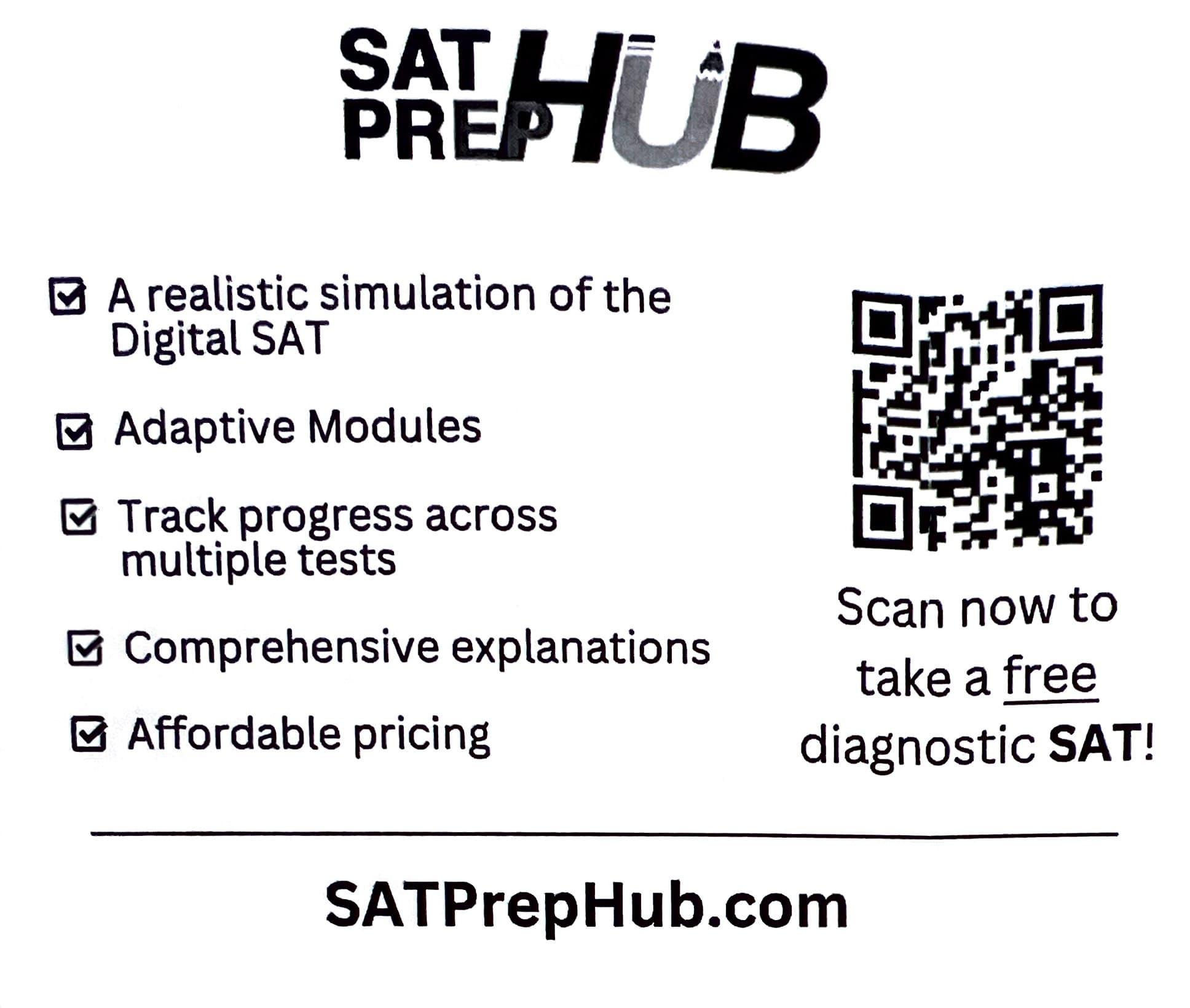

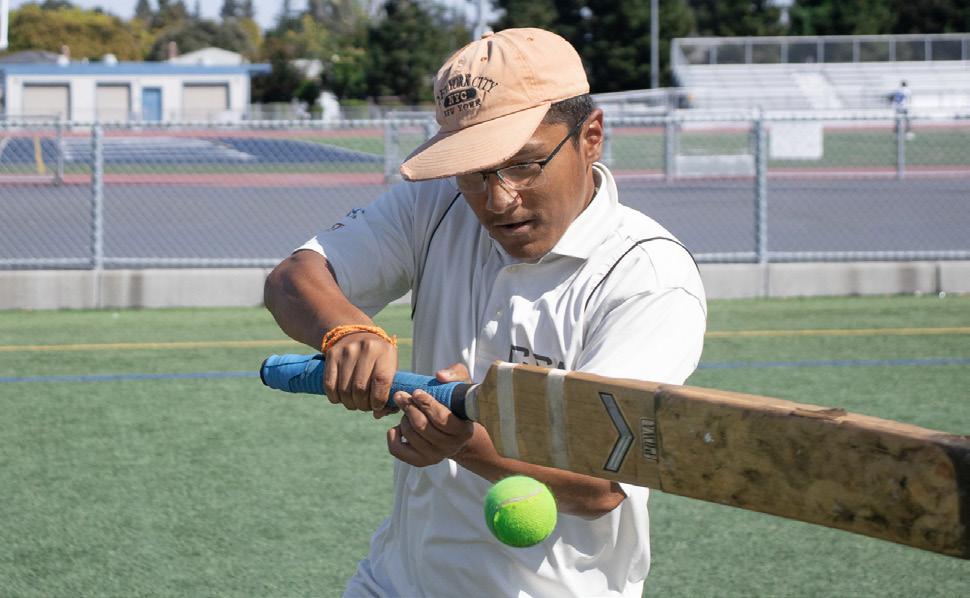
towards offcially recognizing the game of cricket in California.” In practice, ACR 211 means that middle and high schools are now encouraged to organize offcial cricket teams if CIF member schools submit a request to CIF. Chetput has also been in conversation with Athletic Director Jennifer Griffn and Principal Maria Jackson regarding Lynbrook’s implementation of this resolution, which he hopes will take place by the winter season of 2025.
“I know that because ACR-211 passed, players all over California will defnitely be positively impacted,” Chetput said. “Overall, once people get the green light, I feel that many students will ask their schools to create cricket teams.”
Some other long-term priorities include expanding the league to include more schools and increasing the number of players. In less than a year, the team has grown from less than 15 players to nearly 35, and their league which started with three schools has doubled to six. The team has a 9-6 record so far, and an upcoming league tournament is also currently in the works.
I genuinely think that founding the club is one of the defning moments of my high school experience. This is an initiative that will continue long after we graduate.
Aadarsh Rajkumar
Senior
and co-captain
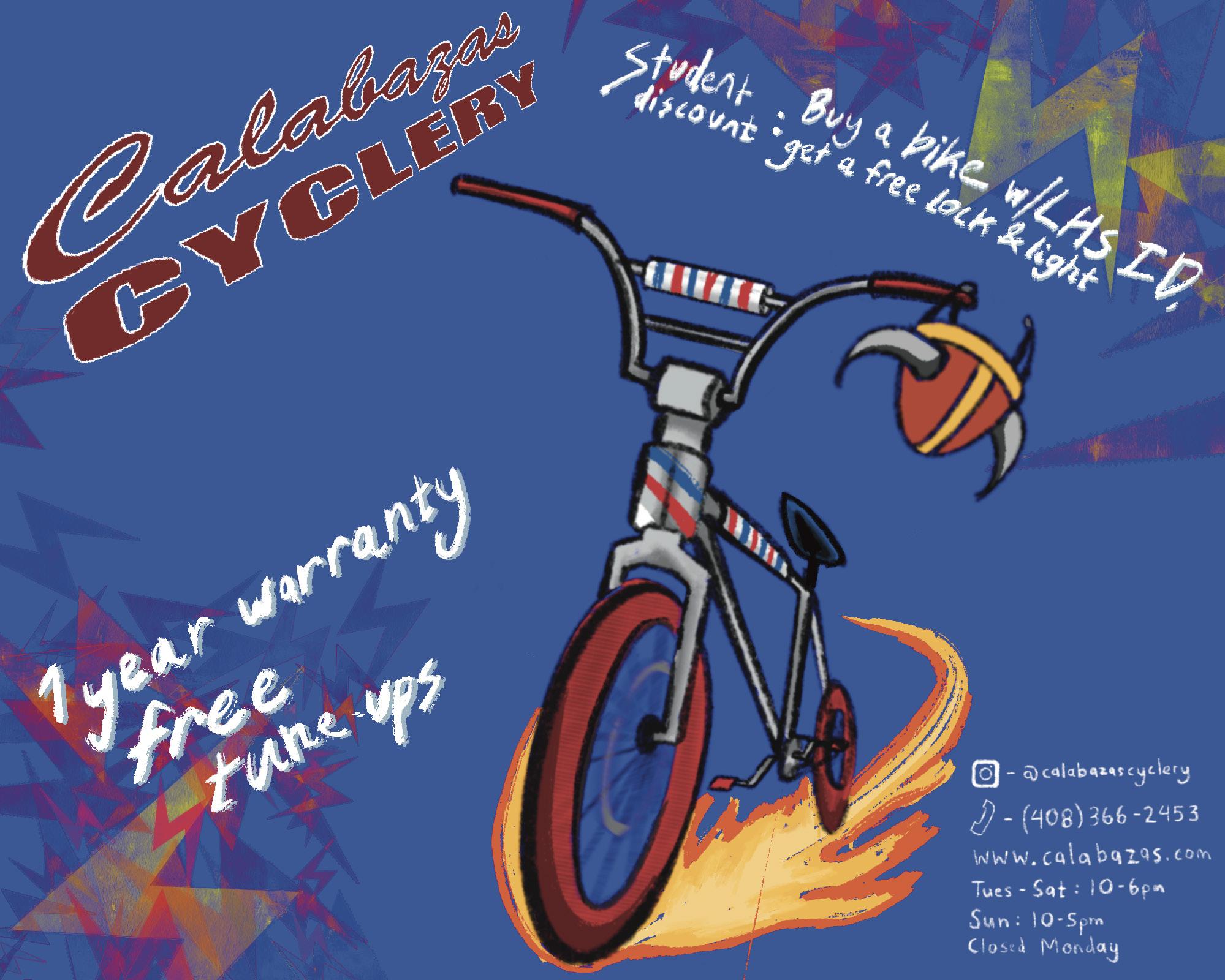
BY GARY PAN
Senior Grace Ker committed to Stanford University for Division I fencing, resulting from years of hard work and training.
Ker frst picked up fencing in fourth grade with the foil style of fencing. She eventually switched to the sabre form.

countries to participate in fencing world cups, Ker often missed days of school. Despite this challenge, Ker grew steadily as a fencer.
“Grace has had nothing but constant improvement,” Cardinal Fencing Club head coach George Pogosov said. “In real life, she is a very sweet girl; when she fences, she’s willing to take smart risks.”
Upon visiting Stanford, Ker was
n July 2024, senior Adithya Venkataraghavan announced his verbal commitment to Cornell University for Division I golf, majoring in fnancial economics. He was frst introduced to golf by his grandfather, turning it into a lifelong passion.
“My favorite part about golf is meeting a lot of new people,” Venkataraghavn said. “The opportunity to learn from them has pushed me and motivated me to be better.”

Venkataraghavan has also had periods of stagnation and failures in his golfng career. Additionally, being a studentathlete was also diffcult. He often had late-night study sessions to make up work. Despite these challenges, Venkataraghavan has persevered.
Venkataraghavan was attending the College Golf Experience Ivy League Camp when he met the coach from Cornell. They began discussing,
commitment.
At Cornell, Venkataraghavan hopes to take advantage of the school’s social scene, meeting many academically intelligent peers and bond with his teammates.
“I look forward to competing on Cornell’s golf team,” Venkataraghavan said. “I’m looking forward to having a good time and meeting new people.”
Read full stories at lhsepic.com.
BY ANUSHKA DESHMUKH
Whether they’re running onto the feld or diving into the pool, Lynbrook athletes have always prided themselves on their team traditions. Chants and inside jokes help create the unique personality of each team and fre up their spirits before games. Through these bonding events and good-luck rituals, athletes have been brought closer together.
Students may be spotted around campus in dress shirts and ties, but they aren’t going to a conference — they’re athletes on the Lynbrook boys water polo team.
“It shows us as mature gentlemen,” senior and team captain Tanay Ubale said. “Our coach is not just trying to build us as players but also as humans.”
However, this is not the only tradition the team has. In the frst weeks of the season, the team focuses on conditioning. In order to add more drag and make swimming harder, the athletes wear onesies during practice.
“Usually swimmers wear tight clothing,” Ubale said. “By adding
onesies, it creates drag, adding diffculty.”
Not only are these traditions fun, but they also bring the team together as a whole.
“Without the traditions, you can’t connect; they help make your teammates into friends,” Ubale said.

The Lynbrook girls volleyball team’s kickoff tournament, also known as the Jamboree, is an anticipated event each year that brings the team closer together. Through this, the girls go from individuals players to a united force on the court.
“Teams from each school scrimmage each other for allotted periods of time,” sophomore Jacey Tseng said. “There’s no score and it’s just for fun, but it signals the start of the season.”
This tournament starts in the morning at 8 a.m. and ends at 12 p.m. This gives the team the rest of the afternoon to select a nice restaurant to begin their frst unoffcial team
bonding session.
“It’s the frst taste of team building and you get to know each other better,” Tseng said.
A team not only gets better through practice, but through getting to know and becoming friends with your teammates.
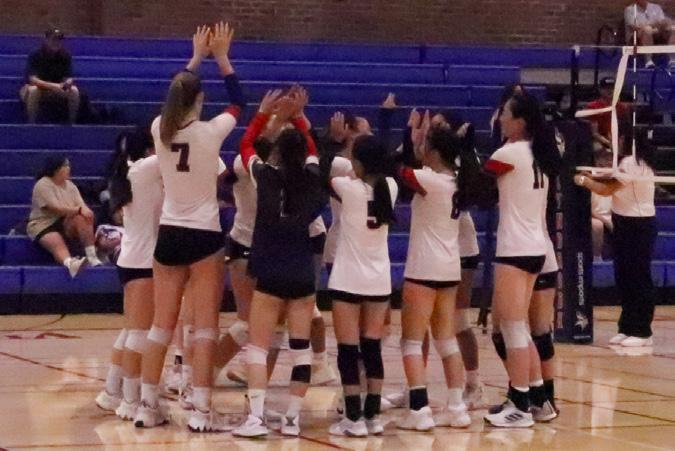
The most important factor in cheer is team spirit. Without a motivated team, Lynbrook’s cheer team wouldn’t be able to inspire the crowd. Because of this, the team has formed their own chants to excite athletes before a routine.
“One of our chants is ‘Who’s the best team on the planet? Cheer, cheer!’ — which makes us feel good about ourselves,” said sophomore Madison Chan.
The cheer team also bonds through events like matching Halloween costumes and decorating a Christmas tree, with the goal of a comfortable atmosphere in the team.
“In these events, we get to know
each other personally,” said Chan. The team aspires to support each other through each of their pursuits. Their unique traditions that value friendship have led to the formation of an amped-up team that is ready for anything.

In the moments before every game, the music fades and the Lynbrook football team pauses warm-ups. They gather around and pray for a good game with no injuries.
“We started the prayer when our coach, Jerome Holloway, came,” senior and team captain Nathan Ye said.
The team has its share of bonding exercises, and even put a unique spin on a common chant.
“The original chant is ‘Vikes on me, Vikes on three. One, two, three, Vikes!’” Ye said. “But instead of ‘Vikes,’ we say ‘family,’ because we value family.”
The chant has formed the
personality that they’re known for, making the chant feel special to them.
“It’s important for every team to have a tradition because you want to have a sense of self that makes you different from other teams,” Ye said. “It creates a bond that lasts a lifetime.”
